new posts in all blogs
Viewing: Blog Posts Tagged with: close reading, Most Recent at Top [Help]
Results 26 - 50 of 51
How to use this Page
You are viewing the most recent posts tagged with the words: close reading in the JacketFlap blog reader. What is a tag? Think of a tag as a keyword or category label. Tags can both help you find posts on JacketFlap.com as well as provide an easy way for you to "remember" and classify posts for later recall. Try adding a tag yourself by clicking "Add a tag" below a post's header. Scroll down through the list of Recent Posts in the left column and click on a post title that sounds interesting. You can view all posts from a specific blog by clicking the Blog name in the right column, or you can click a 'More Posts from this Blog' link in any individual post.

By:
jilleisenberg14,
on 9/7/2014
Blog:
The Open Book
(
Login to Add to MyJacketFlap)
JacketFlap tags:
close reading,
Educator Resources,
Common Core State Standards,
CCSS,
ELA common core standards,
ELL/ESL and Bilingual Books,
children's books,
Bookselling,
librarians,
booksellers,
Reading Aloud,
Educators,
Add a tag
 I highly recommend all educators and parents read a bookseller’s perspective on leveling systems, Lexile in this case, which we re-posted on our blog last week. There are great firsthand examples of parents and booksellers striving in earnest to help children improve in reading.
I highly recommend all educators and parents read a bookseller’s perspective on leveling systems, Lexile in this case, which we re-posted on our blog last week. There are great firsthand examples of parents and booksellers striving in earnest to help children improve in reading.
Regardless of where one comes down on leveling books and assessing students with leveling systems, last week’s post laid bare the lack of or breakdown in communication between all stakeholders about the tools used to assess children’s reading growth.
Whether a child’s reading abilities are measured using Lexile, Accelerated Reader, DRA or another, we must equip any and all stakeholders in a child’s education with knowledge about what these tools mean and concrete ways to further support the child.
Children spend 7,800 hours outside of school each year compared to 900 hours in school. The National Center for Families Learning asserts that “the family unit—no matter the composition—is the one constant across the educational spectrum.” I am extending the definition of a child’s family to include afterschool volunteers, librarians, booksellers, pediatricians, and anyone else involved in a child’s education journey.
 Below are strategies for strengthening the communication lines, sharing resources and context, and building a community invested in each child’s education. In doing so, we show our students, children, and customers that they have a whole team cheering for them and invested in their growth, joy, and success.
Below are strategies for strengthening the communication lines, sharing resources and context, and building a community invested in each child’s education. In doing so, we show our students, children, and customers that they have a whole team cheering for them and invested in their growth, joy, and success.
This week we are tackling what librarians and booksellers can do in preparation for hearing those magical words, “My child has a Lexile score of…” Next week, we will offer strategies for teachers and parents.
For librarians and booksellers who are asked which book for which level:
- Know the local feeder schools to your library or store and ask teachers or the school librarians what leveling systems they are using. Find out how the classroom libraries are organized (by theme, genre, Lexile level, AR level, guided reading level, author). Reaching out to neighborhood schools helps you learn about your customers and build relationships with educators. Ask schools for any booklists or level conversion charts. Schools will be thrilled to recommend their families to places that know their curriculum, leveling systems, and community. Students may move on, but you and teachers are in it for the long haul.
- If schools use multiple or differing leveling systems, ask schools for level conversion charts to have on hand for customers or download your own from Reading Rockets, Booksource, Scholastic Guided Reading Program, Lexile, or Lee & Low. A conversion chart will help you translate what grade level a customer is reading on and books you can recommend within that range.
- Design your own booklists based on grade levels or popular leveling systems. Search by book titles or by levels on Scholastic Book Wizard, Perma-Bound, Lexile’s Find a Book, Accelerated Reader BookFinder, and specific publishers like Lee & Low. Parents and students can reference these handouts as they explore the store.
- Even better: Use other pre-curated lists of popular leveling systems. Remember, you are neither the only nor first bookseller to have a confused nine year old asking what they should read at a Lexile level 930. Share and reach out to teachers and school librarians who may have created lists from which parents and children are requesting. Other persistent souls are tackling these issues as well: Durham County Library and Phoenix Public Library both built a reader’s service to search titles by Lexile, as well as graded and themed booklists.
- Know the Common Core Appendix B text exemplar list. It may not be perfect, but many schools are using these texts to benchmark against other works. Recognizing these books will give you a sense of what the expectations are for each grade level and what students across the country are reading. Pair books in your store or library with this list to help readers discover more contemporary, diverse, and multicultural books.
- If you have children who are reading significantly above their typical grade level and parents that are concerned that higher levels equal too mature content or themes, encourage expository nonfiction. Nonfiction often has higher technical and academic vocabulary bumping up the Lexile or Accelerated Reader levels (as they measure linguistic complexity), but the themes and concepts won’t be mature. When I had three students who were reading two plus grade levels above their peers, I sought out more STEM books that aligned with my third-grade science units, the solar system and animal adaptations. They were able to explore more in-depth about black holes and gravity than we could cover whole group.
- Remember ELL, EFL, ESL, and non-English speaking families. You will most likely have at least a few parents whose first language is NOT English. They will rely even more heavily on you (librarians and bookstore staff) for help finding the right fit book for their child. The more you learn about leveling systems and engage with the neighborhood schools, the more you help the child.

Next week, we will offer strategies for teachers and parents.
What have we missed? Please share in the comments your tricks, tips, and ideas for helping families and children navigate the bookshelves.
 Jill Eisenberg, our Resident Literacy Specialist, began her career teaching English as a Foreign Language to second through sixth graders in Yilan, Taiwan as a Fulbright Fellow. She went on to become a literacy teacher for third grade in San Jose, CA as a Teach for America corps member. She is certified in Project Glad instruction to promote English language acquisition and academic achievement. In her column she offers teaching and literacy tips for educators.
Jill Eisenberg, our Resident Literacy Specialist, began her career teaching English as a Foreign Language to second through sixth graders in Yilan, Taiwan as a Fulbright Fellow. She went on to become a literacy teacher for third grade in San Jose, CA as a Teach for America corps member. She is certified in Project Glad instruction to promote English language acquisition and academic achievement. In her column she offers teaching and literacy tips for educators.
Filed under:
Common Core State Standards,
Educator Resources,
ELL/ESL and Bilingual Books Tagged:
booksellers,
Bookselling,
CCSS,
children's books,
close reading,
Educators,
ELA common core standards,
librarians,
Reading Aloud 


By:
jilleisenberg14,
on 8/16/2014
Blog:
The Open Book
(
Login to Add to MyJacketFlap)
JacketFlap tags:
diversity,
Reading Aloud,
Educators,
reading comprehension,
close reading,
ELA common core standards,
children's books,
Educator Resources,
Common Core State Standards,
CCSS,
ELL/ESL and Bilingual Books,
Add a tag
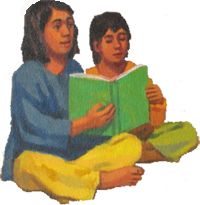 As we cluster in workshops, around webinars, and near the water cooler, we are already thinking about and preparing what skills and knowledge we want to teach. Yet, to truly have a successful year, let’s ponder an additional question: who do we want to teach?
As we cluster in workshops, around webinars, and near the water cooler, we are already thinking about and preparing what skills and knowledge we want to teach. Yet, to truly have a successful year, let’s ponder an additional question: who do we want to teach?
The start of school is a popular time to model and instill core values because August and September are a fresh start: our time as teachers, librarians, and administrators to create and cultivate a community bound and motivated by the same values and goals. It is during this period that we can expose our students to stories with strong morals that feature both examples and non-examples of how to react in tough situations and learn from one’s mistakes.
However, it can be very difficult to select just the right text to teach values that will guide our students through academic and developmental challenges over the coming year and lay the groundwork for the community we hope to build.
Many teachers dust off their tried-and-true character education read alouds each coming school year or rely on word of mouth recommendations that send us back to the classics year in, year out. During my first year of teaching, I remember everyone scrambling to find a book that demonstrated “respect” or “persistence.” When a master teacher on campus mentioned that she used a particular title for the start of every first week of school, that sounded like hard proof to me and I was grateful. I went out and bought it.
Yet, there is not just one book that will make the abstract concept of “empathy” or “leadership” concrete to third graders or kindergartners. With such dependence on the same books, many of my third graders had read The Lorax three years in a row to learn about responsibility and respect. It’s an outstanding book to explore these values, but still…three years? It was time to shake things up.
Whether your school has campus-wide core values or you can determine your own, I encourage you to think carefully about which books you use to teach core values. They are the foundation of a classroom or school’s culture and can guide children’s social, intellectual, and emotional development.
For successful character education study, choose a set of books that:
1. 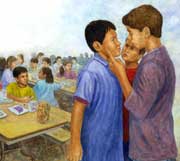 Have protagonists that both exemplify and struggle with at least one of the classroom’s core values. Don’t just present stories with perfect, role model-worthy characters! Students should see multiple examples of people and situations of the core value in action to learn that one’s character is made, not born. Finding books where characters (protagonists and antagonists) lie, cheat, lose their cool, or are hurtful to other characters can be just as powerful as exemplary characters, if not more so. Students can discuss what they can learn from both examples and non-examples, share advice for different scenarios, and reflect on similar experiences in their lives where they struggled to make the right decision.
Have protagonists that both exemplify and struggle with at least one of the classroom’s core values. Don’t just present stories with perfect, role model-worthy characters! Students should see multiple examples of people and situations of the core value in action to learn that one’s character is made, not born. Finding books where characters (protagonists and antagonists) lie, cheat, lose their cool, or are hurtful to other characters can be just as powerful as exemplary characters, if not more so. Students can discuss what they can learn from both examples and non-examples, share advice for different scenarios, and reflect on similar experiences in their lives where they struggled to make the right decision.
2. Are both fiction and nonfiction. Pair fiction with nonfiction texts to show students a range of experiences and real world applications. Reading a biography of a famous leader practicing or struggling with a core value gives students the chance to visualize the core value in their environment and daily lives, as well as let them see that knowing how to make good choices doesn’t come naturally and needs to be practiced.
3. Align with the Common Core ELA Standards. Character education doesn’t need to be separate from ELA instruction or your curriculum. In fact, core value study is great for teaching close reading, determining central ideas and author’s message, analyzing word choice, and comparing two or more texts.
4.  Have protagonists students can identify with based on race, gender, family background, language, and experience. Although students absolutely learn from characters different from themselves, it is very meaningful for children to see someone on the cover and in the pages they identify with struggling or succeeding to make good choices. Especially for younger students, relating to aspects of a character’s identity helps students visualize themselves in the character’s situation and develop empathy. Additionally, for children who are new to school or are English Language Learners, having characters that remind them of themselves or their families may give the children more confidence to participate in class, which is critical to building a strong classroom/school community at the beginning of the year.
Have protagonists students can identify with based on race, gender, family background, language, and experience. Although students absolutely learn from characters different from themselves, it is very meaningful for children to see someone on the cover and in the pages they identify with struggling or succeeding to make good choices. Especially for younger students, relating to aspects of a character’s identity helps students visualize themselves in the character’s situation and develop empathy. Additionally, for children who are new to school or are English Language Learners, having characters that remind them of themselves or their families may give the children more confidence to participate in class, which is critical to building a strong classroom/school community at the beginning of the year.
Looking to refresh your character education read aloud shelf? For book recommendations demonstrating your classroom’s core values, check out our Pinterest boards:

What core values do you teach children? What are your favorite books to teach these core values? Let us know below!
 Jill Eisenberg, our Resident Literacy Expert, began her career teaching English as a Foreign Language to second through sixth graders in Yilan, Taiwan as a Fulbright Fellow. She went on to become a literacy teacher for third grade in San Jose, CA as a Teach for America corps member. She is certified in Project Glad instruction to promote English language acquisition and academic achievement. In her column she offers teaching and literacy tips for educators.
Jill Eisenberg, our Resident Literacy Expert, began her career teaching English as a Foreign Language to second through sixth graders in Yilan, Taiwan as a Fulbright Fellow. She went on to become a literacy teacher for third grade in San Jose, CA as a Teach for America corps member. She is certified in Project Glad instruction to promote English language acquisition and academic achievement. In her column she offers teaching and literacy tips for educators.
Filed under:
Common Core State Standards,
Educator Resources,
ELL/ESL and Bilingual Books Tagged:
CCSS,
children's books,
close reading,
diversity,
Educators,
ELA common core standards,
Reading Aloud,
reading comprehension 


By:
jilleisenberg14,
on 8/2/2014
Blog:
The Open Book
(
Login to Add to MyJacketFlap)
JacketFlap tags:
children's books,
events,
diversity,
Immigration,
Reading Aloud,
Educators,
reading comprehension,
close reading,
Race issues,
Educator Resources,
Common Core State Standards,
Latino/Hispanic/Mexican,
ELL/ESL and Bilingual Books,
Add a tag
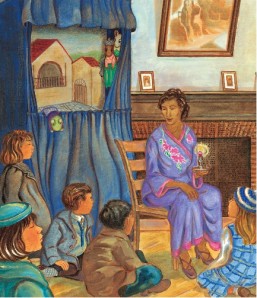 As media coverage has intensified around the events of children crossing the U.S. border, many educators and families are wondering, “What should we tell our students?” For some children, this may be the first time they are learning of these countries. But for many others, these events may involve their own heritage or depict their families’ experiences. Using books to talk about the recent events can be an opportunity to learn about a new region and help children see the cultures and people beyond these events.
As media coverage has intensified around the events of children crossing the U.S. border, many educators and families are wondering, “What should we tell our students?” For some children, this may be the first time they are learning of these countries. But for many others, these events may involve their own heritage or depict their families’ experiences. Using books to talk about the recent events can be an opportunity to learn about a new region and help children see the cultures and people beyond these events.
We’ve put together a list of 11 books (many of which are bilingual English/Spanish) that teach about the emotional journey families and children must undertake along with the physical journey. These stories allow children to see each other and themselves in characters who are living life to the fullest and refusing to let any obstacle stand in their way.
Whether you are looking to explore the themes of the DREAM Act, learn more about the journey of one’s own family, or see America from a different angle, these books reveal the complexities, challenges, joys, and surprises of coming to a new place. Join these characters as they share their challenges and excitement in moving to a new culture and new school, helping their families adjust, and juggling their home culture with a new culture.
 1. A Movie in My Pillow/ Una película en mi almohada
1. A Movie in My Pillow/ Una película en mi almohada
Poet Jorge Argueta evokes the wonder of his childhood in rural El Salvador, a touching relationship with a caring father, and his confusion and delight in his new urban home.
 2. Amelia’s Road
2. Amelia’s Road
Amelia longs for a beautiful white house with a fine shade tree in the yard, where she can live without worrying. In this inspirational tale, Amelia discovers the importance of putting her own roots down in a very special way.

3. First Day in Grapes
Chico and his family move up and down the state of California picking fruits and vegetables. Every September Chico starts at a new school again. Often other children pick on him, but Chico’s first day in third grade turns out to be different.
 4. From North to South/ Del Norte al Sur
4. From North to South/ Del Norte al Sur
José loves helping Mama, but when Mama is sent back to Mexico for not having proper papers, José and his Papa face an uncertain future. Author René Colato Laínez tackles the difficult and timely subject of family separation with exquisite tenderness.
 5. Home at Last
5. Home at Last
Ana Patino is adjusting well to her new life in the United States, but her mother is having a difficult time because she doesn’t speak English. After mama agrees to take English lessons, her sense of confidence and belonging grow.
 6. My Diary from Here to There/ Mi diario de aqui hasta allá
6. My Diary from Here to There/ Mi diario de aqui hasta allá
Amada overhears her parents whisper of moving from Mexico to the other side of the border—to Los Angeles. As she and her family make their journey north, Amada records her fears, hopes, and dreams for their lives in the United States in her diary.
 7. The Storyteller’s Candle/ La velita de los cuentos
7. The Storyteller’s Candle/ La velita de los cuentos
The award-winning team of Lucia González and Lulu Delacre have crafted an homage to Pura Belpré, New York City’s first Latina librarian. Through Pura Belpré’s vision and dedication, the warmth of Puerto Rico comes to the island of Manhattan in a most unexpected way.
 8. The Upside Down Boy/ El niño de cabeza
8. The Upside Down Boy/ El niño de cabeza
Juanito is bewildered by the new school and everything he does feels upside down. But a sensitive teacher and loving family help him to find his voice and make a place for himself in this new world.
 9. When This World Was New
9. When This World Was New
It is Danilito’s first day in America and he is scared. He has heard that some Americans are not friendly to foreigners. In addition, he does not speak any English. Danilito’s worries disappear when Papa leads him on a magical trip of discovery.
 10. Xochitl and the Flowers/ Xóchitl, la Niña de las Flores
10. Xochitl and the Flowers/ Xóchitl, la Niña de las Flores
Miles away from their home in El Salvador, Xochitl and her family make a new home in the United States, but nothing is the same. It is not until her family decides to start a flower nursery in its backyard that Xochitl begins to learn the true value of community in their adopted country.
 11. Calling the Doves/ El canto de las palomas
11. Calling the Doves/ El canto de las palomas
Poet Juan Felipe Herrera shares the story of his migrant farmworker childhood. The farmworker road was the beginning of his personal road to becoming a writer.
 Jill Eisenberg, our Resident Literacy Expert, began her career teaching English as a Foreign Language to second through sixth graders in Yilan, Taiwan as a Fulbright Fellow. She went on to become a literacy teacher for third grade in San Jose, CA as a Teach for America corps member. She is certified in Project Glad instruction to promote English language acquisition and academic achievement. In her column she offers teaching and literacy tips for educators.
Jill Eisenberg, our Resident Literacy Expert, began her career teaching English as a Foreign Language to second through sixth graders in Yilan, Taiwan as a Fulbright Fellow. She went on to become a literacy teacher for third grade in San Jose, CA as a Teach for America corps member. She is certified in Project Glad instruction to promote English language acquisition and academic achievement. In her column she offers teaching and literacy tips for educators.
Filed under:
Common Core State Standards,
Educator Resources,
ELL/ESL and Bilingual Books Tagged:
children's books,
close reading,
diversity,
Educators,
events,
Immigration,
Latino/Hispanic/Mexican,
Race issues,
Reading Aloud,
reading comprehension 


By:
jilleisenberg14,
on 7/20/2014
Blog:
The Open Book
(
Login to Add to MyJacketFlap)
JacketFlap tags:
Summer,
Reading Aloud,
summer reading,
Educators,
reading comprehension,
close reading,
Educator Resources,
ELA common core standards,
children's books,
Add a tag

I and I Bob Marley
Each week this summer, we are pairing Lee & Low titles to your favorite summer destinations with fun activities!
Summer is an incredible time to hear and enjoy music. From public parks to local high school auditoriums to subway platforms, many towns and cities offer summer concerts. Whether it is part of an official concert series, a festival, a rehearsal, or an impromptu get-together of musicians, there are a ton of opportunities to enjoy music alongside reading.
Our motto this summer: Love Books + Keep Cool + Learn Something New
Your summer outing: an Outdoor Summer Concert
Book recommendations:

Summoning the Phoenix
Questions during reading:
- What instruments are used in the book?
- What type of music is featured in this book?
- How is the music in this book different from other kinds of music?
- How does music create community?
- What character traits does someone need to become a successful musician?
- Why do you think people enjoy music and find it meaningful?
- Why do you think every culture has created some form of music?
Activities:
- Pair the book with a music recording or live performance of the same type of music featured in the book. What instruments do you hear? What patterns do you hear? What mood/tone does the music set? How does this music make you feel (unhappy, excited, calm, agitated)? How many musicians are performing? Is there a band leader/conductor for this type of music?
-
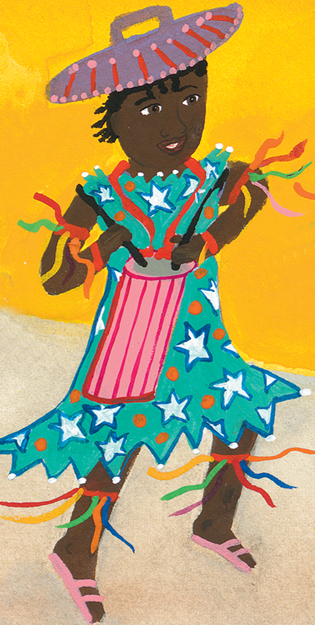
Drummer Boy of John John
Design and create a drum! Although many cultures and forms of music have distinct instruments, it is fascinating to note what instruments seem to pop up over and over again. Take for example the drum! Variations of the drum appear in music from all over the world. Check out the drum instructions from Spark!Lab, part of the Lemelson Center for the Study of Invention and Innovation at the National Museum of American History.
- Turn listening to music into seeing music! Talk about the senses we use to enjoy music. Children may think we can enjoy music with only our ears. Yet, the author and illustrator of the book had to communicate the music and its mood through words and pictures. What words does the author use to describe the featured music? What words does the author use to capture the mood of the music? What colors or actions does the illustrator use to capture the music? After attending a concert or listening to a recording, encourage your child to draw a picture that captures the mood, feeling, or story of the song. What colors would you use for each instrument and why? How would you draw a quiet, slow, fast, or loud moment?
-
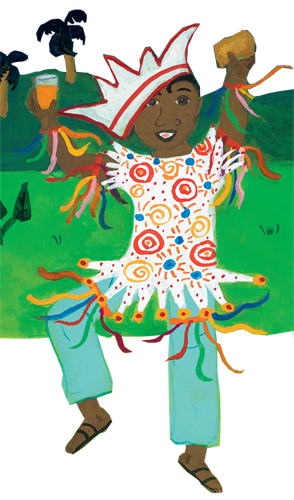
Drummer Boy of John John
Study the geography of the music featured in the book. Where does this type of music originate? Who are famous composers, contributors, or musicians? What kinds of instruments were/are used? Out of what materials from the region were instruments traditionally made?
For further summer reading and ideas:

Jill Eisenberg, our Resident Literacy Expert, began her career teaching English as a Foreign Language to second through sixth graders in Yilan, Taiwan as a Fulbright Fellow. She went on to become a literacy teacher for third grade in San Jose, CA as a Teach for America corps member. She is certified in Project Glad instruction to promote English language acquisition and academic achievement. In her column she offers teaching and literacy tips for educators.
Filed under:
Educator Resources,
Summer Tagged:
children's books,
close reading,
Educators,
ELA common core standards,
Reading Aloud,
reading comprehension,
summer,
summer reading 


By:
jilleisenberg14,
on 7/13/2014
Blog:
The Open Book
(
Login to Add to MyJacketFlap)
JacketFlap tags:
Reading Aloud,
summer reading,
Educators,
environmentalism,
reading comprehension,
close reading,
Summer School,
Educator Resources,
children's books,
Summer,
Add a tag
Grab a flashlight, bug repellent, and binoculars…
Each week this summer, we are pairing Lee & Low titles to your favorite summer destinations with fun activities!
Your summer outing: national or state parks!
Book recommendations:
Questions during reading:
- How have humans affected the habitat or animal species in the book?
- What suggestions does this book offer to take care of the world around us?
- What risks does the animal species or habitat face in the book?
- How does this person(group) demonstrate respect for the environment?
- How do healthy animal populations and habitats benefit people?
- What happens when people do not take care of the environment or an animal species in the book?
- What does this text teach about sustainability?
- Do you think communities and governments have a responsibility to protect animals or the environment? Why or why not?
- Should school field trips include visiting national and state parks? Why or why not? What are the benefits of children visiting national and state parks?
Activity:
1. Sound scavenger hunt!
Many animals rely on sound to detect nearby predators and search for food. For your next scavenger hunt, use the sense of sound to explore the wonders of the state or national park. This activity is a great way to teach young scientists about:
- our five senses
- how the human ear, like other animal ears, is a powerful physical adaptation and is very effective in detecting and differentiating sounds
- how we can appreciate natural beauty as both visual and aural
- the importance of slowing down and soaking in all the stimuli around us
Make a list of sounds for your child to “find” on the next hike. Together, check off and record as the child hears them! While you will want to adapt specific sounds to the park you are visiting, sound ideas include:

Everglades Forever
- the local bird species
- the rustling of an animal in the bushes
- the wind among grass or tree leaves
- sound of the nearest water source (river, ocean)
- the buzzing/humming of insects
- sound of walking on different types of surfaces: the trail, through leaves, in mud
- a hiker whistling
- a swimmer splashing
- a dog barking or the clinking of a dog collar
- sound of something being recycled
- sound of something hollow
- an echo
- sound of food being unwrapped
- horse clopping/trotting
- a stick snapping
- a hiker drinking (chugging) water
- Bonus: the elusive spot of complete silence
To prove that your child experienced the sound, allow your child to:
- record the sounds on a phone
- take a picture of the creature or thing making the noise
- describe the noise in a sentence with a juicy verb, such as chirping instead of singing
2. Animal and ecosystem observation!

Buffalo Song
Even if your nearest state or national park does not have the wildlife or habitat featured in the book, your young scientist can check out the featured animals or habitat in real life and real time from a computer or mobile device. Many national parks, zoos, and wildlife protection groups offer real-time footage of animals that serve as great opportunities to talk about behavioral and physical adaptations and habitat preservation.
Explore.org offers multiple livecam opportunities to observe wild animals outside of zoos. After finishing Buffalo Song, I checked out Canada’s Grasslands National Park for bison. I observed brown bears and salmon from Alaska’s Brooks River in Katmai National Park following I Know the River Loves Me. After A Man Called Raven, I used The Cornell Lab of Ornithology Macaulay Library for videos and audio recordings of ravens.
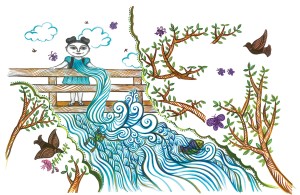
I Know the River Loves Me
For further book and activity suggestions to match your summer adventure:
 Literacy Specialist, Jill Eisenberg, began her career teaching English as a Foreign Language to second through sixth graders in Yilan, Taiwan as a Fulbright Fellow. She went on to become a literacy teacher for third grade in San Jose, CA as a Teach for America corps member. She is certified in Project Glad instruction to promote English language acquisition and academic achievement. In her column she offers teaching and literacy tips for educators.
Literacy Specialist, Jill Eisenberg, began her career teaching English as a Foreign Language to second through sixth graders in Yilan, Taiwan as a Fulbright Fellow. She went on to become a literacy teacher for third grade in San Jose, CA as a Teach for America corps member. She is certified in Project Glad instruction to promote English language acquisition and academic achievement. In her column she offers teaching and literacy tips for educators.
Filed under:
Educator Resources,
Summer Tagged:
children's books,
close reading,
Educators,
environmentalism,
Reading Aloud,
reading comprehension,
summer,
summer reading,
Summer School 


By:
jilleisenberg14,
on 7/6/2014
Blog:
The Open Book
(
Login to Add to MyJacketFlap)
JacketFlap tags:
children's books,
holidays,
diversity,
Summer,
Reading Aloud,
summer reading,
Educators,
reading comprehension,
close reading,
Educator Resources,
Holidays and Celebrations,
Add a tag
Each week this summer, we are pairing Lee & Low titles to your favorite summer destinations with fun activities!
Our motto this summer: Love Books + Keep Cool + Learn Something New
Your summer outing: the BEACH
Book recommendations:

Surfer of the Century: The Life of Duke Kahanamoku
Questions during reading:
- What is this person’s relationship to the ocean? How does this person’s relationship to the ocean change from the beginning to the end of the story?
- How does this person show appreciation for the ocean?
- How is the ocean/beach a part of this person’s identity?
- Look at a map of the world and locate the island this person is from. What is the capital? What ocean surrounds it? Infer what the climate is like based on the island’s location. What makes this island unique?
- How does this person demonstrate pride in his/her culture?
- How does this person remember home even when far away from home?
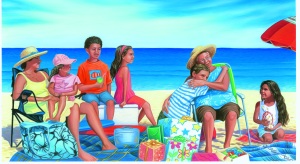 Activity:
Activity:
Create a beach ball collage!
Materials: poster paper, pencil, markers, colored pencils or crayons, assortment of magazines
- Using a pencil, draw a large circle on the poster paper.
- Inside the circle, draw a small circle about the size of a quarter somewhere off center.
- Draw a curved line from the small circle to the large circle. Repeat drawing lines until you have six lines and six spaces. Each curved line should face the same direction in a pinwheel formation. The lines will be different lengths and can be varying widths apart from each other (this will give it a 3-D effect).
- With a black marker, trace over the pencil so the beach ball stands out on the poster paper.
- Optional: lightly fill in each segment a different color using colored pencils or crayons.
- Select and cut out pictures and words from the assortment of magazines to answer the question: What makes the beach special to you?
- In each of the six beach ball segments, draw or glue pictures. In one section, think about what foods you eat while at the beach. What animals have you seen at the beach? What do you always make sure to pack before you head out? What activities do you like to do at the beach? Who do you play with while there?
For further reading: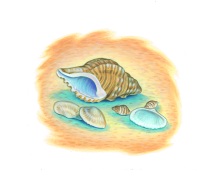
 Jill Eisenberg, our Resident Literacy Expert, began her career teaching English as a Foreign Language to second through sixth graders in Yilan, Taiwan as a Fulbright Fellow. She went on to become a literacy teacher for third grade in San Jose, CA as a Teach for America corps member. She is certified in Project Glad instruction to promote English language acquisition and academic achievement. In her column she offers teaching and literacy tips for educators.
Jill Eisenberg, our Resident Literacy Expert, began her career teaching English as a Foreign Language to second through sixth graders in Yilan, Taiwan as a Fulbright Fellow. She went on to become a literacy teacher for third grade in San Jose, CA as a Teach for America corps member. She is certified in Project Glad instruction to promote English language acquisition and academic achievement. In her column she offers teaching and literacy tips for educators.
Filed under:
Educator Resources,
Holidays and Celebrations,
Summer Tagged:
children's books,
close reading,
diversity,
Educators,
holidays,
Reading Aloud,
reading comprehension,
summer,
summer reading 


By:
jilleisenberg14,
on 6/21/2014
Blog:
The Open Book
(
Login to Add to MyJacketFlap)
JacketFlap tags:
Reading Aloud,
Educators,
reading comprehension,
close reading,
English Language Learners,
Educator Resources,
Common Core State Standards,
ELLs,
ELA common core standards,
ELL/ESL and Bilingual Books,
Add a tag
 Jill Eisenberg, our Resident Literacy Expert, began her career teaching English as a Foreign Language to second through sixth graders in Yilan, Taiwan as a Fulbright Fellow. She went on to become a literacy teacher for third grade in San Jose, CA as a Teach for America corps member. She is certified in Project Glad instruction to promote English language acquisition and academic achievement. In her column she offers teaching and literacy tips for educators.
Jill Eisenberg, our Resident Literacy Expert, began her career teaching English as a Foreign Language to second through sixth graders in Yilan, Taiwan as a Fulbright Fellow. She went on to become a literacy teacher for third grade in San Jose, CA as a Teach for America corps member. She is certified in Project Glad instruction to promote English language acquisition and academic achievement. In her column she offers teaching and literacy tips for educators.
The U.S. Department of Education’s Institute of Education Science (IES) and What Works Clearinghouse (WWC) released the latest educator’s guide to present best instructional practices for English Language Learners. Over the last several weeks, I’ve looked at several different strategies for teaching English Language Learners based on that guide’s recommendations.
Today, we’ll take a look at how to incorporate vocabulary instruction into activities that support listening, speaking, and writing practice for English Language Learners. This is the final week I will focus on the guide’s first recommendation: Teach a set of academic vocabulary words intensively across several days using a variety of instructional activities.

Drumbeat in Our Feet
Using the Lee & Low informational text, Drumbeat in Our Feet, as my model text, I applied the guide’s recommendations on how to choose an appropriate text and words for English Language Learners and how to teach the vocabulary over several days. See how I chose these words here and taught their meanings here.
Using Drumbeat in Our Feet and the IES’s process, my target words are origins, vital, ethnically, diverse, unique, vibrant and varied from the “Origins of African Dance” excerpt.
1. IES: Facilitate structured discussions to increase opportunities for students to talk about academic words. Always anchor these discussions around the topics that are present in the text and that do not have a clear-cut right or wrong answer. The goal is for students to learn to articulate a position or point of view and learn to defend their perspective or analysis. (P. 20)
Lee & Low: Over the course of multiple days, I am teaching a different part to each word’s meaning. After doing so, I want to create open-ended questions for whole or small group discussion that will allow my students to practice using the target words.
As my target words are origins, vital, ethnically, diverse, unique, vibrant and varied from the “Origins of African Dance” excerpt in Drumbeat In Our Feet, I would use these throughout the week for peer-to-peer discussion. This looks like:
- Why would the authors want to discuss the diverse land and countries of Africa in a book about African dance?
- Why might African dance vary in form?
- Why should we study the origins of African dance today?
- What factors might contribute to the diversity in African dance?
2. IES: Require students to use target words in their writing activities. (P. 21)
Lee & Low: Use the prompts above or focus on vocabulary-specific prompts. This looks like:
- What are the origins of your family?
- Write about the origins of a superhero.
- Create a story about the origins of the universe or how life began.
- Is it important to you to feel unique? Why or why not?
- What are at least two things vital to all life forms?
Although we cannot explicitly teach all academic and content-specific words our students will need to know in their educations and careers, we can be strategic in how we teach 5-8 words a week so they can apply these word strategies to new words they come across on their own.
Further reading on supporting English Language Learners in the classroom:
Filed under:
Common Core State Standards,
Educator Resources,
ELL/ESL and Bilingual Books Tagged:
close reading,
Educators,
ELA common core standards,
ELLs,
English Language Learners,
Reading Aloud,
reading comprehension 


By:
jilleisenberg14,
on 5/17/2014
Blog:
The Open Book
(
Login to Add to MyJacketFlap)
JacketFlap tags:
common core standards,
CCSS,
ELLs,
Curriculum Corner,
guided reading,
ELA common core standards,
Institute of Education Science,
middle school,
Reading Aloud,
elementary school,
vocabulary,
US Department of Education,
close reading,
English Language Learners,
Add a tag
 Jill Eisenberg, our Resident Literacy Expert, began her career teaching English as a Foreign Language to second through sixth graders in Yilan, Taiwan as a Fulbright Fellow. She went on to become a literacy teacher for third grade in San Jose, CA as a Teach for America corps member. She is certified in Project Glad instruction to promote English language acquisition and academic achievement. In her column she offers teaching and literacy tips for educators.
Jill Eisenberg, our Resident Literacy Expert, began her career teaching English as a Foreign Language to second through sixth graders in Yilan, Taiwan as a Fulbright Fellow. She went on to become a literacy teacher for third grade in San Jose, CA as a Teach for America corps member. She is certified in Project Glad instruction to promote English language acquisition and academic achievement. In her column she offers teaching and literacy tips for educators.
The U.S. Department of Education’s Institute of Education Science (IES) and What Works Clearinghouse (WWC) released the latest educator’s guide to present best instructional practices for English Language Learners.
Although we cannot explicitly teach all academic and content-specific words our students will need to know in their educations and careers, we can be strategic in how we teach 5-8 words a week so they can apply these word strategies to new words they come across on their own.
Last week I applied the guide’s recommendations on how to choose an appropriate text and vocabulary words for English Language Learners and I modeled it with the Lee & Low informational text, Drumbeat In Our Feet.
I will continue to focus on the guide’s first recommendation: Teach a set of academic vocabulary words intensively across several days using a variety of instructional activities.

Drumbeat In Our Feet
Using Drumbeat In Our Feet and the IES’s process, my target words are origins, vital, ethnically, diverse, unique, vibrant and varied from the “Origins of African Dance” excerpt in Drumbeat In Our Feet. See how I chose these words here.
1. Read the text
IES: Introduce the topic of the text by asking about students understanding of the topic and personal experiences. Read the excerpt aloud at the start of the lesson. (P. 24)
Lee & Low: I would read the text aloud so students who cannot comprehend the text independently can access the text whole group. All students should be able to follow along with their own student copy. Only constant interaction with the print and following along will allow students to connect with what I am saying and how I say it with what they are seeing in the print.
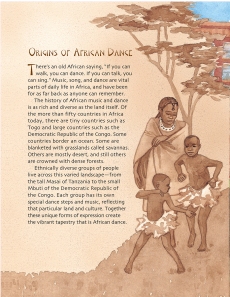
“Origins of African Dance,” excerpt from Drumbeat In Our Feet
2. Introduce the vocabulary
IES: After reading the text and stopping to ask clarifying questions, introduce the target vocabulary words and have students find the words (in their copies). Display a list of the words in the classroom. (P. 24)
3. Teach the vocabulary words in layers
IES: “Teach academic vocabulary in depth using multiple modalities (writing, speaking, listening)” and “teach word-learning strategies to help students independently figure out the meaning of words.” (P. 18-22)
Lee & Low: Over the course of 5-8 days (lesson periods), I would focus on a couple of aspects of each of the new vocabulary words. On a whole class chart where the target words are listed, I would add a new component to each word each day in order to deepen the meaning and foster familiarity with the words for students.
Together we will create a student-friendly definition; write synonyms, antonyms, examples, non-examples; determine parts of speech; draw a picture or create an action/gesture to represent the words; list related word forms and any cognates; break the word down into word parts; and use the word in a meaningful, student-generated sentence.
For example, Monday I would read the excerpt, introduce the target words, find the target words in the text, and come up with a definition for each target word. Tuesday, I would revisit the chart and add synonyms, antonyms, examples, and non-examples for all the vocabulary words to reinforce meaning. Wednesday I would cover part of speech and concrete representations, and so on.
Below is how I would teach my target word, origins, from Drumbeat In Our Feet but I would cover all of the target words each day.
Monday
- student-friendly definition: the source where something starts
Tuesday
- synonyms: beginnings, birthplace, roots, foundation
- antonyms: end, destination, result
- examples: beginning of the universe and life, family backgrounds/heritage, word roots, superhero/comic book origin stories
- non-examples: death of a star, the youngest person in the family tree, the last book in a comic book series
Wednesday
- part of speech: noun
- draw a picture to represent the word: I might draw a lake with a river leading up to a mountain and arrow pointing to where the river starts.
- create an action/gesture to represent the word: with my left hand held out at hip-level as the “lake,” I would point with my right finger to my left shoulder (the mountain) as the origin of the river. [Tip: Students are great at brainstorming concrete representations of words!]
Thursday
- list related word forms: original, originate
- list any cognates: origine (French), origen (Spanish)
Friday
- affixes: none
- use the word in a meaningful, student-generated sentence: We hiked from the lake up to the mountain looking for the origins of the river. The original owner of this house built this house all on her own in 1956.
Remember: This is a process I will repeat each week or every 5-8 lessons with a new text and set of target words. While my students may know only up to 400 new vocabulary words by the end of the year, this repeated process will allow them to tackle new vocabulary words in other content classes and in independent reading.
Next week, we will take a look at how to incorporate the selected vocabulary into activities that support listening, speaking, and writing practice for English Language Learners.
Further reading on supporting English Language Learners in the classroom:
Filed under:
Curriculum Corner Tagged:
CCSS,
close reading,
common core standards,
ELA common core standards,
elementary school,
ELLs,
English Language Learners,
guided reading,
Institute of Education Science,
middle school,
Reading Aloud,
US Department of Education,
vocabulary 


By:
jilleisenberg14,
on 5/10/2014
Blog:
The Open Book
(
Login to Add to MyJacketFlap)
JacketFlap tags:
middle school,
elementary school,
vocabulary,
ell,
reading comprehension,
close reading,
English Language Learners,
common core standards,
CCSS,
Curriculum Corner,
ELA common core standards,
informational nonfiction,
Add a tag
 Jill Eisenberg, our Resident Literacy Expert, began her career teaching English as a Foreign Language to second through sixth graders in Yilan, Taiwan as a Fulbright Fellow. She went on to become a literacy teacher for third grade in San Jose, CA as a Teach for America corps member. She is certified in Project Glad instruction to promote English language acquisition and academic achievement. In her column she offers teaching and literacy tips for educators.
Jill Eisenberg, our Resident Literacy Expert, began her career teaching English as a Foreign Language to second through sixth graders in Yilan, Taiwan as a Fulbright Fellow. She went on to become a literacy teacher for third grade in San Jose, CA as a Teach for America corps member. She is certified in Project Glad instruction to promote English language acquisition and academic achievement. In her column she offers teaching and literacy tips for educators.
As I mentioned last week, the U.S. Department of Education’s Institute of Education Science (IES) and What Works Clearinghouse (WWC) released the latest educator’s guide to present best instructional practices for English Language Learners.
Let’s take a look at the guide’s first recommendation: Teach a set of academic vocabulary words intensively across several days using a variety of instructional activities.
Here is an example of how to apply the first recommendation using IES’s process and Lee & Low Books’ informational nonfiction text, Drumbeat In Our Feet.

Drumbeat In Our Feet
- Choose a text:
IES: “Choose a text that is brief, interesting, and engaging for the students; contains a variety of target academic words to focus on; connects to a given unit of study and builds the students’ knowledge of a topic; provides sufficient detail and examples for students to be able to comprehend the passage; and contains ideas that can be discussed from a variety of perspectives.” (P. 14)
Lee & Low: Based on these criteria, I selected the first chapter, “Origins of African Dance.” The reading level of Drumbeat In Our Feet is best suited for fourth through sixth graders. The topic of dance history is relatable and relevant to this age group. It will spark student interest and engagement and promote discussion. The short excerpt is an appropriate length that can be read within one class period and is worth multiple re-readings over the coming days.
- Select vocabulary:
IES: Select a small number of academic vocabulary words (content-specific and general academic) for multi-day instruction. For in-depth exploration, consider only 5-8 words. The IES suggests choosing words “central to understanding the text, frequently used in the text, might appear in other content areas, with multiple meanings, with affixes, or cross-language potential.” (P. 16-17)
Lee & Low: Based on these criteria, I picked: origins, vital, ethnically, diverse, unique, vibrant and varied from the “Origins of African Dance” excerpt in Drumbeat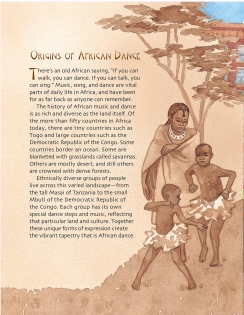 In Our Feet. These words are key to understanding the text, will appear in other content areas students will explore, and several have multiple meanings.
In Our Feet. These words are key to understanding the text, will appear in other content areas students will explore, and several have multiple meanings.
Additionally, I used Flocabulary’s Wordlists to check my words against their grade level recommendations because Flocabulary’s researchers analyze grade level materials and high stakes tests to determine what academic words students should know in each grade. Origins is on the third grade word list and variety (related word form to varied) is on the fourth grade word list. Vital, diversity (related word form to diverse), unique, and vibrant are on the sixth grade word list. However, there are quite a few wordlists available to do this verification so utilize what your district/school recommends or another you have confidence using.
Next week, we will take a look at how to introduce and teach the selected vocabulary across multiple lesson periods using Drumbeat In Our Feet followed by writing and speaking/listening activities for your students to grasp the words’ meanings.
Further reading on supporting English Language Learners in the classroom:
Filed under:
Curriculum Corner Tagged:
CCSS,
close reading,
common core standards,
ELA common core standards,
elementary school,
ell,
English Language Learners,
informational nonfiction,
middle school,
reading comprehension,
vocabulary 


By:
jilleisenberg14,
on 4/19/2014
Blog:
The Open Book
(
Login to Add to MyJacketFlap)
JacketFlap tags:
History,
poetry,
slavery,
Educators,
National Poetry Month,
reading comprehension,
close reading,
African/African American Interest,
common core standards,
CCSS,
Curriculum Corner,
appendix b,
ELA common core standards,
Add a tag
 Jill Eisenberg, our Resident Literacy Expert, began her career teaching English as a Foreign Language to second through sixth graders in Yilan, Taiwan as a Fulbright Fellow. She went on to become a literacy teacher for third grade in San Jose, CA as a Teach for America corps member. She is certified in Project Glad instruction to promote English language acquisition and academic achievement. In her column she offers teaching and literacy tips for educators.
Jill Eisenberg, our Resident Literacy Expert, began her career teaching English as a Foreign Language to second through sixth graders in Yilan, Taiwan as a Fulbright Fellow. She went on to become a literacy teacher for third grade in San Jose, CA as a Teach for America corps member. She is certified in Project Glad instruction to promote English language acquisition and academic achievement. In her column she offers teaching and literacy tips for educators.
1. Teaching Students About Narrator Bias
Etched In Clay is a compelling case study for narrator bias and trustworthiness. The text structure with 13 narrators and its economy of words make Dave’s story captivating, especially to middle grade  students who are beginning to engage with primary sources from the period of American slavery. Students can analyze how each speaker’s social experiences, status, motivations, and values influence his/her point of view, such as evaluating the poems of the slave-owners who would have had a vested interest in popularizing a particular narrative of slavery.
students who are beginning to engage with primary sources from the period of American slavery. Students can analyze how each speaker’s social experiences, status, motivations, and values influence his/her point of view, such as evaluating the poems of the slave-owners who would have had a vested interest in popularizing a particular narrative of slavery.
Using multiple perspectives to tell the story of one life is a striking display of how events can be interpreted and portrayed by different positions in the community. Students face the task of examining the meaning and nuance of each narrator (13 in total!) and what they choose to convey (or don’t).
Discussion questions include:
- Why might the author choose to share Dave’s story using multiple speakers? How do multiple narrations develop or affirm the central idea?
- How do the author’s choices of telling a historical story in present tense and first person narration affect our sympathy toward the narrators and events in the book?
- Select a poem, such as “Nat Turner,” and defend why the author chose a particular narrator to tell that event or moment. How would the event and poem be different if another, like Reuben Drake, had told it?
- Are there narrators the readers can trust more than others? Why or why not? What makes a narrator (un)trustworthy? How is each narrator (un)reliable? Why might one of these narrators not tell readers the “whole” truth? Does having more than one narrator make the story overall more reliable? Why or why not?
- How does a narrator’s position in society or in Dave’s life affect what he/she knows? How does the historical context affect what a narrator may or may not know and his/her reliability? How can readers check a narrator’s knowledge of facts?
- What is the motivation of each narrator to share?
- Does this alternation between narrators build compassion or detachment for Dave in readers? How so?
- Why is it important to learn the history of slavery from slaves themselves?
- Compare and contrast the conditions of slavery from Dave’s point of view and Lewis Miles.
- How do the slaveholders depict the relationships with their slaves? How do the slaves depict their relationships with the slaveholders?
- Compare Dave and Lewis Miles’ perceptions of the Civil War.
- Consider whether Dave and David Drake should be considered one perspective or two.
- Contrast how each narrator feels about antebellum South Carolina.
- Who might be the audience the narrators are telling their version of events to (themselves, God, a news reporter, etc.)? Are they the same? Why is intended audience important to consider?
- Argue whether 13 points of view flesh out this figure or make Dave and his life even more elusive.
2. Poetry Month and Primary Sources
As “Primary Sources + Found Poetry = Celebrate Poetry Month” suggests, the Library of Congress proposes an innovative way to combine poetry and nonfiction. Teaching With The Library of Congress recently re-posted the Found Poetry Primary Source Set that “supports students in honing their reading and historical comprehension skills by creating poetry based upon informational text and images.” Students will study primary source documents, pull words and phrases that show the central idea, and then use those pieces to create their own poems.
This project not only enables teachers to identify whether a student grasps a central idea of a text, but also encourages students to interact with primary sources in much the same way as Etched In Clay’s Andrea Cheng. When researching Dave’s life and drawing inspiration for her verses, Andrea Cheng integrated the small pieces of evidence of Dave’s life, including poems on his pots and the bills of sale.
3. Common Core and the Appendix B Document
Many middle school educators are currently using Henrietta Buckmaster’s “Underground Railroad,” a recommended text exemplar for grades 4-5, and Ann Petry’s Harriet Tubman: Conductor on the Underground Railroad and Frederick Douglass’s Narrative of the Life of Frederick Douglass An American Slave, Written by Himself, recommended text exemplars for grades 6-8 in the Common Core State Standards’ Appendix B document.
Educators can couple Etched In Clay with those texts to involve reluctant or struggling readers, prepare incoming middle school students, and scaffold content and language for English Language Learners. Additionally, Andrea Cheng’s biography offers educators an inquiry-based project for ready and advanced readers to analyze “how two texts address similar themes or topics in order to build knowledge or to compare the approaches the authors take” (CCSS.ELA-LITERACY.CCRA.R.9).
For a more inclusive, diversity-themed collection of contemporary authors and characters of color, check out our Appendix B Diversity Supplement.
Further reading:
Andrea Cheng on Writing Biography in Verse
A Poem from Etched in Clay
Filed under:
Curriculum Corner Tagged:
African/African American Interest,
appendix b,
CCSS,
close reading,
common core standards,
Educators,
ELA common core standards,
History,
National Poetry Month,
poetry,
reading comprehension,
slavery 


By:
jilleisenberg14,
on 4/15/2014
Blog:
The Open Book
(
Login to Add to MyJacketFlap)
JacketFlap tags:
children's books,
diversity,
geography,
Educators,
environmentalism,
classroom projects,
reading comprehension,
close reading,
digital literacy,
visual literacy,
common core standards,
CCSS,
Curriculum Corner,
ELA common core standards,
geoliteracy,
Add a tag
Throughout April, we are exploring how Jan Reynolds’ Vanishing Cultures series can be used in the classroom to teach about the environment, geo-literacy, global citizenship, and nonfiction. Today, we want to share how one school has integrated geo-literacy with digital and visual literacy.
Michael Willis and the Kaleidoscope Team at Williston Central School in Williston, Vermont helped their 3rd and 4th grade classroom build a map on Google Maps of the cultures featured in the books. Through this project, students were able to investigate topics and themes in the Vanishing Cultures series, practice deriving information from other formats and develop visual literacy skills, and gain rich social studies/ geography content knowledge.
The Google Maps assignment is an exciting way to engage reluctant or struggling readers, facilitate the participation of visual learners and English Language Learners, or provide an extension opportunity for ready or advanced learners. The 3rd and 4th grade students hope that in addition to deepening their own knowledge about traditional cultures, their project provides useful and valuable information for others.
From educator, Michael Willis: My 3rd and 4th grade team wanted to get an author in to share their experiences with our young writers. Ideally we wanted a local person and sure enough Jan Reynolds, who lives in Vermont, was available. First we hit up our library as well as the others in our area and got our hands on Jan’s Vanishing Cultures series. We read aloud her books, visited her website, and then Jan came.
She shared a movie about her work and travels with our whole team in the auditorium and then spent time answering questions in smaller groups. It was during one of the small presentations that Jan mentioned how great it would be to use Google Maps to highlight her book locations. I thought it would be a great project for our students, and they were motivated to do it by the idea that the project could be shared with other students who read Jan’s books.
We used Google Maps to plot out where in the world Jan’s Vanishing Cultures books take place, and put together this map.

Williston Central School Google Earth Map for Vanishing Cultures series
Here’s what the students had to say about the project:
What was it like doing the Google Earth Project?
Grace – I thought that it was really fun because we were working with a famous author. We had to get all of her books and look up where she had been using Google Earth.
Isabelle – We dropped pins on the locations using the facts and map information on the inside covers of her books. Doing this project motivated us to have to read her books and learn about the cultures that she visited. It made me appreciate how lucky we are to have the things we have.
Logan – The map project was really interesting. It helped me understand how many different places Jan had been. I didn’t know that there were cultures vanishing from the Earth. It made me want to learn more about the cultures. The books were helpful because she had really been to visit the people, talk to them, and learn how they live.
Addie – We used the summaries and the content from the books to add a brief description to the pins which marked the places. This project motivated us because we wanted to help others learn. It felt special because we were the first ones to do this and actually get published! Plus, I didn’t even know these cultures existed!
Myleigh – The motivating part of the project was that I don’t usually get to explore the world. How often do people get to learn about this kind of thing? It was almost like traveling the world reading Jan’s books.
What do you think is the purpose of Jan’s books? What do they help you realize?
Sean – Her purpose was to teach children about the Vanishing Cultures and what is happening to them. I think Jan’s message was not that they need our help because they have been surviving for a long time. She was telling us that we should respect them, their way of life, and to respect their land. I learned that they are just like everyday people. To them, I bet we would look like the outsiders. Everyone has traditions that they do.
Addie – We are lucky to have so many resources to use.
Grace – It made me realize how different these cultures are from us
Isabelle – It also made me realize that we all are not that different. We may have different stuff and live in different parts of the world, but we all are people.
Grace – We can help other cultures by protecting the regions where they live
Addie – We realized that while our cultures are different, we shouldn’t force them to disappear because we all have something to learn from each other. We could be more conscious of our waste and our pollution and that could help them keep their culture and survive
Isabelle – I think that it is important to respect different cultures because it’s how they live. The Celebrations book helped me learn that different cultures celebrate different holidays
What was it like having Jan visit?
Myleigh – It was really cool to see Jan’s presentation and to hear her describe her trips first hand. It really helped me put myself in her shoes and understand what she was going through. When I was hearing her use such descriptive language it felt like I was right there with her.
Katrina – I think that since she came it really helped us understand that you should appreciate what you have – even though the people in the other cultures don’t have a lot they still seemed happy. The people in those cultures work hard to live off the land and work with nature by using their resources. It really helped me learn about cultures that I didn’t know about.
For more resources on the Vanishing Cultures series, check out:
How are you using the Vanishing Cultures series in your classroom? Share your thoughts, experiences, and strategies that have worked in your school and community! Post a comment below or email Lee & Low at [email protected].
Filed under:
Curriculum Corner Tagged:
CCSS,
children's books,
classroom projects,
close reading,
common core standards,
digital literacy,
diversity,
Educators,
ELA common core standards,
environmentalism,
geography,
geoliteracy,
reading comprehension,
visual literacy 


By:
jilleisenberg14,
on 4/8/2014
Blog:
The Open Book
(
Login to Add to MyJacketFlap)
JacketFlap tags:
children's books,
diversity,
Reading Aloud,
geography,
Educators,
environmentalism,
reading comprehension,
close reading,
Multiracial,
common core standards,
CCSS,
Curriculum Corner,
guided reading,
ELA common core standards,
geoliteracy,
vanishing cultures,
Add a tag
Jill Eisenberg, our Resident Literacy Expert, began her career teaching English as a Foreign Language to second through sixth graders in Yilan, Taiwan as a Fulbright Fellow. She went on to become a literacy teacher for third grade in San Jose, CA as a Teach for America corps member. She is certified in Project Glad instruction to promote English language acquisition and academic achievement. In her column she offers teaching and literacy tips for educators.
Eisenberg, our Resident Literacy Expert, began her career teaching English as a Foreign Language to second through sixth graders in Yilan, Taiwan as a Fulbright Fellow. She went on to become a literacy teacher for third grade in San Jose, CA as a Teach for America corps member. She is certified in Project Glad instruction to promote English language acquisition and academic achievement. In her column she offers teaching and literacy tips for educators.

Vanishing Cultures: Mongolia
Last week on the blog we spotlighted the work of Jan Reynolds, an author and explorer who has written nonfiction for young readers about cultures across the globe. If we had read the Vanishing Cultures series when I was a classroom teacher, my students would have been competing with each other over who knew the most outrageous fact. Did you know the Tiwi, an aboriginal tribe from an island off the coast of Australia, eat mangrove worms fresh? Did you know the Inuit from the Hudson Bay build rock piles that are stacked to look like men in order to scare caribou toward the real Inuit hunters?
My students loved to play the “did you know…” game. That became a popular sentence starter in our classroom. Students would scramble for the latest book or periodical on animals, prehistoric times, and exotic locales. The peregrine falcon, megalodon, and the giant panda were unshakable favorites.
Yet, we don’t want students to know “just facts” as if they are mini-encyclopedias. We aspire for our students to wonder and to investigate how our world works, how we are all connected to our environment and other humans halfway around the globe, and how our actions here affect others way over there.
The Common Core brings a refreshed spotlight to the nonfiction genre in children’s books, challenging publishers, educators, librarians, and parents to present children with high interest, high quality texts. What a time to engage students’ senses, sustain their wonder, and teach them geo-literacy!
National Geographic affirms, “with the rapid pace of change in the 21st century, it is more important than ever that young people understand the world around them.” It has adopted the concept of “geo-literacy,” and even gone so far as to create a community to support and cultivate “geo-educators.”

Vanishing Cultures: Himalaya
Enjoyed in classrooms around the nation, Jan Reynolds’ collection on at-risk traditional cultures is even more significant and striking today than when the series was first published. The persistent popularity of the Vanishing Cultures series speaks to its captivating power to make geo-literacy learning personal and tangible. This collection supports geo-literacy learning because each book challenges students to examine:
- the characteristics of each culture
- what makes this featured culture unique
- how this group of people has adapted to survive in its environment
- what challenges this group of people faces
- the modern human impact (positive and negative) on this traditional culture and the environment
- why the author would want to share this story with children and create a whole series on this topic
When we educate children about other cultures and geo-literacy more broadly, we are implanting the idea that we learn in order to make better, more informed decisions. Before our students become adults in positions of power, we want them to have practice in pausing and thinking how their choices to construct their community could disturb the environment of another community or animal species.
The Vanishing Cultures books encourage students to reason and reflect critically and deeply about how humans affect other humans and why we all benefit from diversity. As classrooms around the country can attest, Jan Reynolds’ books will not only spark enthusiasm that we hope ignites into lifelong careers and hobbies, but also conversation on what information we need to make decisions that will shape our and others’ health, environment, and well-being.

Vanishing Cultures: Down Under
Classroom Ideas for Comparing and Contrasting Between Vanishing Cultures Books and Teaching Geo-Literacy
(Reading Standards, Integration of Knowledge & Ideas, Strand 9)
(Writing Standards, Research to Build & Present Knowledge, Strand 7 and 9)
- How are these cultures similar and different from each other? What actions do these families take in both books to protect their ways of life?
- Compare how the challenges of each culture are similar or different.
- Compare how the children in each book demonstrate their pride in their culture. Why is it important for the children to feel proud of who they are and their way of life?
- What is the author’s purpose in starting each book with the parents telling their child a story from long ago? How does this affect the tone of and set the mood in the series? How does this opening support the central idea?
- After reading two or more of the Vanishing Cultures books, what common features or characteristics does a Vanishing Culture book have? If you were to write a book about your family’s culture, what kinds of things happen in a Vanishing Cultures book? What are some things that will not happen in a Vanishing Cultures book? What central ideas and lessons will be in the book?
- Have students create a chart to compare different aspects of life across two or more cultures. Write the name of each cultural group being compared on the top of the chart, and list the topics for points of comparison down the left side. Here are some possible topics: Food, Clothing, Climate, Geography, Important Animals, Homes, How Children Help (Chores), Roles of Men & Women, Family Life, How People Have Fun, Beliefs, Means of Transportation, Challenges Faced Today, Celebrations, Honoring Loved Ones. Have students record appropriate information as they read and re-read the texts.
- One elementary class created the “Around the World with Jan Reynolds” project on Google Earth. Explore where each of the books takes place. Compare the political map with the satellite map. Reflect on how geography has helped or hurt the survival of these ancient cultures. Students can create their own maps of the different cultures at National Geographic’s MapMaker’s 1-Page Maps.
Filed under:
Curriculum Corner Tagged:
CCSS,
children's books,
close reading,
common core standards,
diversity,
Educators,
ELA common core standards,
environmentalism,
geography,
geoliteracy,
guided reading,
Multiracial,
Reading Aloud,
reading comprehension,
vanishing cultures 


By:
jilleisenberg14,
on 3/17/2014
Blog:
The Open Book
(
Login to Add to MyJacketFlap)
JacketFlap tags:
children's books,
History,
biography,
Educators,
white house,
reading comprehension,
close reading,
differentiation,
character analysis,
common core standards,
CCSS,
bloom's taxonomy,
Curriculum Corner,
guided reading,
rigor,
ELA common core standards,
higher level thinking,
Add a tag
 Jill Eisenberg, our Resident Literacy Expert, began her career teaching English as a Foreign Language to second through sixth graders in Yilan, Taiwan as a Fulbright Fellow. She went on to become a literacy teacher for third grade in San Jose, CA as a Teach for America corps member. She is certified in Project Glad instruction to promote English language acquisition and academic achievement. In her column she offers teaching and literacy tips for educators.
Jill Eisenberg, our Resident Literacy Expert, began her career teaching English as a Foreign Language to second through sixth graders in Yilan, Taiwan as a Fulbright Fellow. She went on to become a literacy teacher for third grade in San Jose, CA as a Teach for America corps member. She is certified in Project Glad instruction to promote English language acquisition and academic achievement. In her column she offers teaching and literacy tips for educators.
First Lady Michelle Obama travels to China this week from March 19-26 and will be focusing on the power and importance of education. In an open letter to American students, the First Lady writes, “During my trip, I’ll be visiting a university and two high schools in Beijing and Chengdu (which are two of China’s largest cities). I’ll be talking with students about their lives in China and telling them about America and the values and traditions we hold dear. I’ll be focusing in particular on the power and importance of education, both in my own life and in the lives of young people in both of our countries.”
We at Lee & Low Books wish we could join the First Lady, but since we can’t this time around, we will be reading the biography of one of China’s greatest statesmen, poets, and humanitarians, Su Dongpo. This scholar is a shining example of how persistence and dedication to one’s studies lead to achievement beyond the classroom and enable one to affect meaningful change.

Su Dongpo, Chinese Genius
This biography presents a rich setting for Standard 3 of the Common Core State Standards: character analysis. We follow Bloom’s Taxonomy to illustrate the range of questions you can use to meet your students’ needs and access their literary strengths. By creating a progression of questions within one standard, we differentiate for students within a class, provide extension opportunities for ready learners, or move the whole class from literal- to higher-level thinking over the course of several readings.
Knowledge:
- What are Su Dongpo’s appearance/physical attributes, deeds/actions, thoughts/dialogue, and feelings/emotions?
- What are other character’s opinions of and reactions to Su Dongpo?
- Can you select sections showing how Su Dongpo relates to other characters?
- How would you describe Su Dongpo in a paragraph?
Comprehension:
- How would you classify Su Dongpo’s character trait(s) based on these actions, thoughts, and feelings above?
- How would you summarize Su Dongpo’s opinion or feelings about Wang Anshi?
- How would you describe Su Dongpo’s feelings about being banished from his job and home?
- What problems does Su Dongpo face and how does he solve them?
- How would you summarize Su Dongpo’s opinion about the purpose of government?
Application:
- When Su Dongpo was twenty, he took the official exams and earned status as the First Scholar for his academic achievements. Based on what you know about Su Dongpo’s character traits, how would he have handled the situation differently if he had not earned such high marks the first time?
- How would Su Dongpo react if his brother, Su Ziyou, became a corrupt government official?
- What would need to happen or change for Su Dongpo to work for Emperor Zhezong?
- How would Su Dongpo distinguish a “good” government from a “bad” government?
- What would Su Dongpo likely think about our end of the year state assessments or the Common Core State Standards?
- What advice do you think Su Dongpo would have for students who take state and national tests today?
- If Su Dongpo worked for the U.S. Department of Education, what might Su Dongpo feel and think about the role of education in America today?
Analysis:
- How did Su Dongpo’s upbringing prepare him for his career in government?
- What inspired Su Dongpo’s beliefs about the purpose of government?
- Why did Su Dongpo not care about “instant glory” or “worldly fame” when making a decision?
- Compare Su Dongpo and Wang Anshi’s motivations for working in the government.
Synthesis:
- Compose and present a speech that will communicate the thoughts and feelings of Su Dongpo to the Chinese people after he is pardoned when Emperor Zhezong dies.
- Imagine you are Su Dongpo and write a diary account of your daily thoughts and activities. What would you say about the work that you do, the people you meet in government and in the villages, and the challenges you face?
- Rewrite the scene of Su Dongpo hearing he is pardoned after the death of Emperor Zhezong. What would Su Dongpo feel and what would the Chinese people think about him if he were not pardoned?
Evaluation:
- Defend whether you would or would not like Su Dongpo to work in your government.
- Argue what lessons Su Dongpo learned from his career in and out of government.
- How effective is Su Dongpo as a humanitarian?
- Determine whether Su Dongpo was or was not disrespectful of government.
- Assess whether Su Dongpo changed from the beginning to the end of the book based on his character traits.
Additional resources:
Sign up for updates from the First Lady throughout her trips and opportunities to ask questions.
Explore PBS LearningMedia for the First Lady’s blog, a map of China, and other resources.
Filed under:
Curriculum Corner Tagged:
biography,
bloom's taxonomy,
CCSS,
character analysis,
children's books,
close reading,
common core standards,
differentiation,
Educators,
ELA common core standards,
guided reading,
higher level thinking,
History,
reading comprehension,
rigor,
white house 


By:
jilleisenberg14,
on 3/3/2014
Blog:
The Open Book
(
Login to Add to MyJacketFlap)
JacketFlap tags:
Educators,
reading comprehension,
close reading,
CCSS,
Curriculum Corner,
ELA common core standards,
children's books,
diversity,
Reading Aloud,
Add a tag
 Jill Eisenberg, our Resident Literacy Expert, began her career teaching English as a Foreign Language to second through sixth graders in Yilan, Taiwan as a Fulbright Fellow. She went on to become a literacy teacher for third grade in San Jose, CA as a Teach for America corps member. She is certified in Project Glad instruction to promote English language acquisition and academic achievement. In her column she offers teaching and literacy tips for educators.
Jill Eisenberg, our Resident Literacy Expert, began her career teaching English as a Foreign Language to second through sixth graders in Yilan, Taiwan as a Fulbright Fellow. She went on to become a literacy teacher for third grade in San Jose, CA as a Teach for America corps member. She is certified in Project Glad instruction to promote English language acquisition and academic achievement. In her column she offers teaching and literacy tips for educators.

Home to Medicine Mountain
My students and their siblings were often alone or spent a lot of time with each other. For some, siblings were the only constant in their lives. Fittingly, siblings and close-in-age relatives held powerful sway and influence over each other.
I found that brothers, sisters, cousins, and neighbors saw each other’s success as their OWN success. One of my third-graders danced in the middle of the carpet for twelve minutes after he heard the intercom announcement that his fifth-grade sister would be the new school president of the student council. What if I could channel that excitement towards literacy?
Brothers and sisters WANTED to see their siblings succeed. Sure, when one of my third-graders struggled to translate from English to Spanish that she hadn’t turned her homework in for a week at the parent-teacher conference, her older sister was delighted to impart the correct information to their mother.
In addition to using siblings for accountability and parent-teacher bridges, siblings became an incredible reward and relationship in my classroom. When my students, especially the struggling readers, made it to a new level, aced an assessment, or turned in excellent high-quality work, I wrote laudatory notes and let those students deliver them to their siblings in another classroom.

Mama Elizabeti
This system turned out to be just as powerful as a celebratory phone call home to adults, but I was recognizing the child in real time and recognizing the strength of the family presence at school. And it went further: the younger or older sibling was able to celebrate my student in their classroom and admire them publicly amidst their peers for academic achievement. There are not enough Dollar Tree prizes to compete with that kind of reward.
Beyond my school, psychologists have noticed the effect older brothers and sisters can have. In fact, NPR explored the positive and negative consequences of older sibling influence in a segment called, “Big Sibling’s Big Influence: Some Behaviors Run In The Family.”
At Arlington Elementary in Arlington, Tennessee, The Jackson Sun reported how teachers are recruiting older students to read to younger students in their Big Brothers, Big Sisters Reading Club every morning before school. More advanced students can relate to struggling readers and explain strategies in a friendly, non-high-stakes atmosphere.
In Carmel Valley, California, the Read To Me Project is an early literacy program that builds school readiness by engaging elementary brothers and sisters to read to their siblings. So far, 350 participating older siblings are reading to 443 young children across four school districts.
For Dr. Seuss’ Birthday last year at my school in the Bay Area, our kindergarten teachers invited the third-graders to read to them. Everyone was ecstatic to read to their brother, sister, cousin, or neighbor. My scholars had the opportunity to show off the chapter books they were tackling and feel like experts as they helped the kinders decode and recognize sight words. The kinders, in turn, received extra reading time, exposure to high-quality texts, and an opportunity to show off how remarkable their older sibling was.
One of my students who was an advanced learner, but had a very unstable home life, was very, very protective of his three younger brothers. His active kinder brother had refused to read with any third-grader, hiding each time another class of third-graders came throughout the day. Not until the last period arrived and his third-grade brother, my student, finally appeared did this kinder cuddle up to read. Even though my student brought a dense, picture-less chapter book on sharks and their presence in Fiji cultural traditions, his kinder brother sat in rapt attention for nearly an hour soaking in every word from his big brother.
We know the results on a child’s motivation and confidence when parents relish in their child’s success, so why don’t we harness that effect from siblings as well? Equipping our children with the love for reading and the skills needed to confront real world problems involves every stakeholder in our children’s lives—and that may include their smallest (but loudest!) cheerleaders.
If you need more inspiration, check out these books with strong sibling relationships:

Summer of the Mariposas
Filed under:
Curriculum Corner Tagged:
CCSS,
children's books,
close reading,
diversity,
Educators,
ELA common core standards,
Reading Aloud,
reading comprehension 

I have truly fallen in love with Falling in Love With Close Reading, the just-released book by Christopher Lehman and Kate Roberts. As with Kylene Beers and Robert Probst’s Notice and… Read More →

By:
Hannah,
on 9/16/2013
Blog:
The Open Book
(
Login to Add to MyJacketFlap)
JacketFlap tags:
common core standards,
CCSS,
Curriculum Corner,
ELA common core standards,
listening and speaking standards,
Reading Standards,
writing standards,
reading,
Civil Rights,
guest blogger,
integration,
close reading,
Add a tag

 Katherine Ali is a dual-certified elementary and special education teacher. She recently graduated as a literacy specialist with a Masters in Science from Manhattanville College. She has experience teaching internationally in northern China and now teaches in the Bronx, NY.
Katherine Ali is a dual-certified elementary and special education teacher. She recently graduated as a literacy specialist with a Masters in Science from Manhattanville College. She has experience teaching internationally in northern China and now teaches in the Bronx, NY.
In order to be active participants in the literate world, students must be reading, writing, speaking, and listening at all ages. The natural interplay of language looks slightly differently across grades levels, but the foundations and mission are the same:
Reading: Text Complexity and the growth of comprehension
We want our students to ascend the staircase of text complexity and simultaneously sharpen their comprehension skills. Students, of all ages, need to build stamina through independently reading more rigorous and complex texts. Additionally, read-alouds allow students to access content and concepts they may not be able to decode themselves.
Writing: Text types, responding to reading, and research
Opinion pieces, research-based projects, and narratives are the three main categories of student writing the Common Core State Standards focus on. It is also imperative that our students engage in the writing process and expand their writing style using the conventions of the English language.
Speaking & Listening: Flexible Communication and Collaboration
Speaking and Listening in each grade level includes but is certainly not limited to presentations, group work, and class discussion. Students need to be aware of their oral language skills and communicate their thoughts and research appropriately. Building off other students’ ideas is also an important component in developing these skills.
Last week, I explained what what it looks like to integrate reading, writing, speaking, and listening in grades K-1, using the book Rainbow Stew as an example. This week, I take a look at grades 2-3:
 As Fast As Words Could Fly by Pamela M. Tuck, illus. by Eric Valesquez
As Fast As Words Could Fly by Pamela M. Tuck, illus. by Eric Valesquez
Interest Level: 2 -7
DRA: 34, Guided Reading Level: O
Reading: Doing a close read with students of As Fast As Words Could Fly fulfills the Common Core’s shift up the staircase of text complexity and builds strong vocabulary skills. Words such as refused, boasted, disbelief, barricaded, grimaces, and blurted are rich and valuable for second and third graders to read and understand. This text is also an excellent model of the use of dialogue. Through close reading activities students can highlight the dialogue and the speaker to understand the different ways to properly punctuate dialogue in a narrative. Of course, teachers can also read this story aloud so students can connect to the themes of perseverance and overcoming adversity.
Writing: Tuck’s writing style is strong and complex. She uses compound sentences, prepositions, and onomatopoeia throughout the story creating a very sophisticated narrative. Teachers can focus on one of these skills in a Writing Workshop model in which students translate the skill into their own writing. Mason’s story also evokes different opinions and feelings that lead to rich discussion. Use these discussion questions as a guide and encourage students to write a Reader’s Response and to share their responses 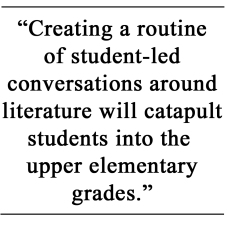 with the class.
with the class.
Speaking & Listening: By second and third grade, students should be developing their formal presentation skills, therefore they may share Mason’s story through a presentation about influential people who took risks (complement the study with this interview with Moses Teel Jr., whose experience as a teenager during integration was the basis for Mason’s story).
Students also need to learn to lead discussions. Assign a group of students to be the leaders of an interactive read-aloud and have them come prepared with various questions they developed in advance with the classroom teacher. Creating a routine of student-led conversations around literature will catapult students into the upper elementary grades.
Stay tuned next week, when I discuss how to integrate reading, writing, speaking, and listening standards for grades 4-5 using Bird.
Filed under:
Curriculum Corner,
guest blogger Tagged:
CCSS,
Civil Rights,
close reading,
common core standards,
ELA common core standards,
integration,
listening and speaking standards,
reading,
Reading Standards,
writing standards 


By:
Hannah,
on 9/9/2013
Blog:
The Open Book
(
Login to Add to MyJacketFlap)
JacketFlap tags:
common core standards,
CCSS,
Curriculum Corner,
ELA common core standards,
listening and speaking standards,
Rainbow Stew,
Reading Standards,
writing standards,
literacy,
guest blogger,
kindergarten,
reading comprehension,
close reading,
Add a tag

 Katherine Ali is a dual-certified elementary and special education teacher. She recently graduated as a literacy specialist with a Masters in Science from Manhattanville College. She has experience teaching internationally in northern China and now teaches in the Bronx, NY.
Katherine Ali is a dual-certified elementary and special education teacher. She recently graduated as a literacy specialist with a Masters in Science from Manhattanville College. She has experience teaching internationally in northern China and now teaches in the Bronx, NY.
As educators, we witness the transformations of students throughout elementary school. First graders will one day become fifth graders, while fifth graders were once first graders. So we must think, where did our students come from? and where are they going next? Our classroom must be structured to prepare our students for the future and help them build a skillset they can bring with them. In order to be active participants in the literate world, students must be reading, writing, speaking, and listening at all ages.
Here on the LEE & LOW blog, I’ll illustrate what it looks like to integrate reading, writing, speaking, and listening across several grade levels: K-1, 2-3, and 4-5. The natural interplay of language looks slightly different across grade levels, but the foundations and mission are the same.
Reading: Text Complexity and the growth of comprehension
We want our students to ascend the staircase of text complexity and simultaneously sharpen their comprehension skills. Students of all ages need to build stamina through independently reading more rigorous and complex texts. Additionally, read-alouds allow students to access content and concepts they may not be able to decode themselves.
Writing: Text types, responding to reading, and research
The three main categories of student writing the standards focus on are opinion pieces, research-based projects, and narratives. It is also imperative that our students engage in the writing process and expand their writing style using the conventions of the English language.
Speaking and Listening: Flexible Communication and Collaboration
Speaking and Listening in each grade level includes (but is certainly not limited to) presentations, group work, and class discussion. Students need to be aware of their oral language skills and communicate their thoughts and research appropriately. Building off other students’ ideas is also an important component in developing these skills.
Over the next few weeks, I’ll share a few titles published by LEE & LOW BOOKS that illustrate opportunities for integrating oral and written language in the classroom. The stories can be used in different capacities depending on students’ interest and ability; therefore I focus on the interest level as well as the guided reading level to determine each book’s grade-level appropriateness. Furthermore, while the mini-lesson ideas and strategy-based activities are categorized by each key feature, they are still connected.
Grades K-1
Rainbow Stew by Cathryn Falwell
Interest Level: Grades K -3
DRA: 16, Guided Reading: I
Reading: The rhythm and rhyming of Rainbow Stew (“Whimper, sigh, cloudy sky, is it to wet to play? We don’t want to stay inside/ because of rain today“) make it a fantastic read aloud. Teachers can model how to use the bright, colorful pictures and other context clues to unlock the meaning of unfamiliar words such as “soggy” and “grasshopper.”
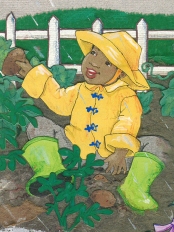
image from Rainbow Stew
Students can also practice reading together through choral reading exercises in either whole class or small group instruction. Choral reading supports struggling readers and strengthens fluency. Students are also then listening to the rhythm and rhyming of the author’s words repeatedly. Additionally, students may be able to read this story independently to practice fluency and build vocabulary. For emergent readers, this text can be a tool to teach phonemic awareness and word patterns as well.
Writing: Author Cathryn Falwell uses a methodical writing style of action words followed by rhyming verses. Young learners can discuss the writer’s craft in this picture book as well as notice some nuances in the different verses with strong scaffolding. Teachers can lead a shared writing project in which the class borrows Falwell’s style and writes their own book, playing with words. Another age-appropriate reading and writing strategy presented in Rainbow Stew is sequencing. Students will need to refer to the story in order to recount the events by either drawing pictures or writing.
Speaking & Listening: Teachers can facilitate an interactive read-aloud in which students turn and talk to one another about the story. Asking questions such as, “What other stories does Rainbow Stew remind you of?” adheres to the reading standards in making connections across different texts and fosters intentional discussions. Through the choral reading exercise students are reading, speaking, and listening to the text. Creating a class book improves collaboration skills such as taking turns, listening to other’s ideas, and compromising.
Stay tuned next week as I demonstrate how to integrate reading, writing, speaking & listening for grades 2-3 using As Fast As Words Can Fly by Pamela Tuck!
Further Reading:
Integrating Reading, Writing, Speaking, and Listening in the Classroom
What Does Close Reading Look Like in Kindergarten?
Filed under:
Curriculum Corner,
guest blogger Tagged:
CCSS,
close reading,
common core standards,
ELA common core standards,
kindergarten,
listening and speaking standards,
literacy,
Rainbow Stew,
reading comprehension,
Reading Standards,
writing standards 


By:
Jaclyn DeForge,
on 3/18/2013
Blog:
The Open Book
(
Login to Add to MyJacketFlap)
JacketFlap tags:
common core standards,
Curriculum Corner,
common core text sets,
text sets,
compiling rigorous text sets,
thematic text sets,
Book Lists,
Resources,
Reading Aloud,
close reading,
Add a tag
 Jaclyn DeForge, our Resident Literacy Expert, began her career teaching first and second grade in the South Bronx, and went on to become a literacy coach and earn her Masters of Science in Teaching. In her column she offers teaching and literacy tips for educators. This is the second in a series of posts on thematic text sets.
Jaclyn DeForge, our Resident Literacy Expert, began her career teaching first and second grade in the South Bronx, and went on to become a literacy coach and earn her Masters of Science in Teaching. In her column she offers teaching and literacy tips for educators. This is the second in a series of posts on thematic text sets.
One aspect of the Common Core that I get asked questions about all the time is thematic text sets. What are they? How do you know which books to use? What types of texts should you be pairing together?
Fear not! I’ve compiled some examples of text sets that cover one topic and span multiple genres and reading levels. Some of the titles you may already have in your classroom library, and others I think you’ll enjoy discovering. In my first post, I compiled books about the moon. Today we look at books about Kenya:
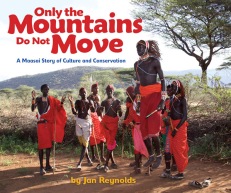
Theme/topic: Kenya
Grade: 3rd-4th
Informational Text: Only the Mountains Do Not Move by Jan Reynolds (Guided or Shared Reading)
- provides information about the Maasai people of Kenya
- can be used to address informational text standards
(a free Teacher’s Guide is available for this title)
Realistic Fiction: First Come the Zebra by Lynne Barasch (Independent Reading)
- the main characters in the story are from the Kikuyu and Maasai tribes
- can be used to address literature standards
(a free Teacher’s Guide is available for this title)
Narrative Nonfiction: Brothers in Hope: The Story of the Lost Boys of Sudan by Mary Williams (Read Aloud)
- the story chronicles the Lost Boys’ journey from southern Sudan to Kenya
- can be used to address informational text and literature standards
(a free Teacher’s Guide is available for this title)
Biography: Seeds of Change: Planting a Path to Peace by Jen Cullerton Johnson (Read Aloud)
- discusses the life and contributions of Nobel Peace Prize winner Wangari Maathai
- can be used to address informational text and literature standards
(a free Teacher’s Guide is available for this title)
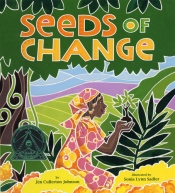
What books would you put on this list? Add your favorites in the comments!
Further Reading: Thematic Text Set: The Moon (2nd grade)
Filed under:
Curriculum Corner,
Resources Tagged:
Book Lists,
close reading,
common core standards,
common core text sets,
compiling rigorous text sets,
Reading Aloud,
text sets,
thematic text sets 

 This week, another look at the Common Core State Standards (CCSS). Dr. Nancy N. Boyles in the Educational Leadership article, Closing in on Close Reading, Vol. 7 No. 4, states,
This week, another look at the Common Core State Standards (CCSS). Dr. Nancy N. Boyles in the Educational Leadership article, Closing in on Close Reading, Vol. 7 No. 4, states,
We can’t wait until middle school to teach students to read closely. Three practices bring close reading to the lower grades. . . 1) use short texts, 2) aim for independence, 3) focus on observing and analyzing.
When I read Dr. Boyle’s article, I realized that close reading wasn’t new, but a re-newel of analytic reading, “Close reading means reading to uncover layers of meaning that lead to deep comprehension,” this uncovering of layers allows the reader to examine the meaning of the parts and relate the reading selection to other texts.
Close, analytic reading stresses engaging with a text of sufficient complexity directly and examining meaning thoroughly and methodically, encouraging students to read and reread deliberately. (Partnership for Assessment of Readiness for College and Careers, 2011, p. 7)
Some believe that reading instruction for the past ten years has focused too heavily on strategies rather than the text. Here are Dr. Boyle’s three recommendations to engage elementary students in close reading.
- Use Short Texts–not to abandon longer texts, but studying shorts texts is helpful if we want to enable students with a wide range of reading levels to practice closely reading demanding texts. Traditional literature lends itself to close reading, such as folktales, legends,, myths, fables, short stories, poetry, and scenes from plays. Children’s listening comprehension outpaces their reading comprehension in the early grades, so being read to as well as independent reading can build knowledge.
- Aim for Independence–go beyond ho-hum questions and ask a sequence of questions that will lead students more deeply into a text. Teach students to ask the questions so that students can take what they learn from the study of one text and apply it to the next text they read.
- Focus on Observing and Analyzing–see whether students have noticed the details of a passage and can recount those details. If students can’t paraphrase the basic content of a passage, how can they dig for its deeper meaning?
Related articles:
Graphic from stunningbooks.wordpress.com


By:
Jaclyn DeForge,
on 1/14/2013
Blog:
The Open Book
(
Login to Add to MyJacketFlap)
JacketFlap tags:
Resources,
reading comprehension,
close reading,
guadalupe garcia mccall,
common core standards,
Under the Mesquite,
slow reading,
Curriculum Corner,
guided reading,
what does close reading look like in fifth grade?,
Add a tag
 Jaclyn DeForge, our Resident Literacy Expert, began her career teaching first and second grade in the South Bronx, and went on to become a literacy coach and earn her Masters of Science in Teaching. In her column she offers teaching and literacy tips for educators.
Jaclyn DeForge, our Resident Literacy Expert, began her career teaching first and second grade in the South Bronx, and went on to become a literacy coach and earn her Masters of Science in Teaching. In her column she offers teaching and literacy tips for educators.
Over the past several weeks, I’ve been modeling how to do a close reading at several different grade levels. To close out the series: Close Reading in Fifth Grade using the X level text Under the Mesquite by Guadalupe Garcia McCall.
One way to structure close reading questioning is to use the format laid out by the Institute for Learning of the University of Pittsburgh. Under their framework, students read the text selection four times: first, to get the gist; second, to find significant moments or ideas; third, to interpret the ideas in the text; and finally, to analyze the author’s methods (craft). Here’s an example of how to plan out your questions for close reading of the first poem of Under the Mesquite, entitled ”the story of us.”

1st reading (read to get the gist):
- Who is the narrator? What have we learned about her? What can we infer about her so far? Cite evidence from the text to support your answer.
- What is Mami like? What have we learned about her? What can we infer about her so far? Cite evidence from the text to support your answer.
- What happened in the first poem? What was Lupita doing? What was she looking for? What does she find? How does Mami react? What can you infer about their relationship? Cite evidence from the text to support your answer.
2nd reading (read to find significant moments or ideas):
- What is the most important thing you learned or that happened in this section of the text? Why is it significant? What was the purpose of this poem? Cite evidence from the text to support your answer.
3rd reading (read to interpret ideas):
- “No, today I am Eve in the garden, / stealing secretos, / mining for knowledge, / hoping for a taste / of the forbidden fruit.” What is this section of the poem an allusion to? What does this reference reveal about Lupita and her background? Cite evidence from the text to support your answer.
- Why does Mami keep Lupita’s umbilical cord? What does it mean to her? What is the cord a symbol of? What does that tell you about their relationship? Cite evidence from the text to support your answer.
4th reading (read to analyze the author’s methods/craft):
- How is this text organized? How is it different from other novels you’ve read? How is it similar? Cite evidence from the text to support your answer.
- What is the tone of the piece? Formal? Informal? Serious? Light? etc. What effect does the tone have on the way the audience reads the piece? Cite evidence from the text to support your answer.
- What are some of the strongest images Garcia McCall has created so far? How do these images set the mood for the piece? Cite evidence from the text to support your answer.
By asking students to ground their responses in the text by citing text-based support for their answers, the following Common Core Standard is addressed:
Reading Literature, Grade 5, Key Ideas and Details, Strand 1: Quote accurately from a text when explaining what the text says explicitly and when drawing inferences from the text.
How does close reading look in your classroom? Any tricks and tips to share?
Further reading:
Filed under:
Curriculum Corner,
Resources Tagged:
close reading,
common core standards,
guadalupe garcia mccall,
guided reading,
reading comprehension,
slow reading,
Under the Mesquite,
what does close reading look like in fifth grade? 


By:
Jaclyn DeForge,
on 12/10/2012
Blog:
The Open Book
(
Login to Add to MyJacketFlap)
JacketFlap tags:
History,
Resources,
Reading Aloud,
Andrea Cheng,
reading comprehension,
close reading,
common core standards,
slow reading,
Curriculum Corner,
guided reading,
Etched in Clay,
Add a tag
 Jaclyn DeForge, our Resident Literacy Expert, began her career teaching first and second grade in the South Bronx, and went on to become a literacy coach and earn her Masters of Science in Teaching. In her column she offers teaching and literacy tips for educators.
Jaclyn DeForge, our Resident Literacy Expert, began her career teaching first and second grade in the South Bronx, and went on to become a literacy coach and earn her Masters of Science in Teaching. In her column she offers teaching and literacy tips for educators.
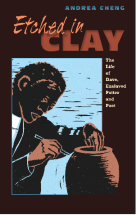 Over the past several weeks, I’ve been modeling how to do a close reading at several different grade levels. Next up: Close Reading in Fourth Grade using the T level text Etched in Clay: The Life of Dave, Enslaved Potter and Poet written and illustrated by Andrea Cheng, out this January!
Over the past several weeks, I’ve been modeling how to do a close reading at several different grade levels. Next up: Close Reading in Fourth Grade using the T level text Etched in Clay: The Life of Dave, Enslaved Potter and Poet written and illustrated by Andrea Cheng, out this January!
One way to structure close reading questioning is to use the format laid out by the Institute for Learning of the University of Pittsburgh. Under their framework, students read the text selection four times: first, to get the gist; second, to find significant moments or ideas; third, to interpret the ideas in the text; and finally, to analyze the author’s methods (craft). Here’s an example of how to plan out your questions for close reading of the introduction through the first 13 pages of Etched in Clay:
1st reading (read to get the gist):
- Who is Dr. Abner Landrum? What have we learned about him? What can we infer about him so far? Cite evidence from the text to support your answer.
- Who is Harvey Drake? What have we learned about him? What can we infer about him so far? Who is Amos Landrum? How is Harvey different than Amos? Cite evidence from the text to support your answer.
- Who is Dave? What have we learned about him? What can we infer about him so far? How does he feel about the work he’s been given to do? About being renamed “Dave”? About his first pottery lesson? Cite evidence from the text to support your answer.
- What major events have occurred so far? How much time has passed? During what period in history are the events taking place? How do you know? What do you know about this period in American history that can help your reading of the text? Cite evidence from the text to support your answer.
- What was important to Dr. Abner Landrum? Cite evidence from the text to support your answer.
2nd reading (read to find significant moments or ideas):
- What is the most important thing you learned or that happened in this section of the text? Why is it significant? Cite evidence from the text to support your answer.
3rd reading (read to interpret ideas):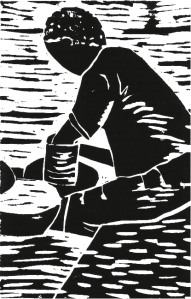
- In the poem “Augusta Auction”, how does the auctioneer view Dave? How does Harvey Drake view Dave? What can you infer about how Harvey Drake feels about slavery? Cite evidence from the text to support your answer.
- On page 7 in the poem “Augusta Auction,” Harvey Drake describes the slaves at auction as follows: “The Negro mothers wail/while their children cling to them/like melons to their vines.” Cheng’s passage serves two purposes, one descriptive and one historical/sociological. Discuss the dual meanings of the image she creates. Cite evidence from the text to support your answer.
4th reading (read to analyze the author’s methods/craft):
- How is this text organized? How is it different than other biographical texts or historical fiction you’ve read? How is it similar? Cite evidence from the text to support your answer.
- Who is the audience for this text? Why does Andrea Cheng consistently shift narrator? What effect does this have on how the story is told and how the information is presented? Cite evidence from the text to support your answer.
- What are some of the strongest images Cheng has created so far? How do these images set the mood for the piece? Cite evidence from the text to support your answer.
By asking students to ground their responses in the text by citing text-based support for their answers, the following Common Core Standard is addressed:
Reading Literature, Grade 4, Key Ideas and Details, Strand 1: Refer to details and examples in a text when explaining what the text says explicitly and when drawing inferences from the text.
How does close reading look in your classroom? Any tricks and tips to share?
Further reading:
Filed under:
Curriculum Corner,
Resources Tagged:
Andrea Cheng,
close reading,
common core standards,
Etched in Clay,
guided reading,
History,
Reading Aloud,
reading comprehension,
slow reading 


By:
Jaclyn DeForge,
on 12/3/2012
Blog:
The Open Book
(
Login to Add to MyJacketFlap)
JacketFlap tags:
Resources,
Reading Aloud,
Educators,
reading comprehension,
Ken Mochizuki,
close reading,
Baseball Saved Us,
Dom Lee,
common core standards,
slow reading,
Curriculum Corner,
guided reading,
Add a tag
 Jaclyn DeForge, our Resident Literacy Expert, began her career teaching first and second grade in the South Bronx, and went on to become a literacy coach and earn her Masters of Science in Teaching. In her column she offers teaching and literacy tips for educators.
Jaclyn DeForge, our Resident Literacy Expert, began her career teaching first and second grade in the South Bronx, and went on to become a literacy coach and earn her Masters of Science in Teaching. In her column she offers teaching and literacy tips for educators.
Over the past several weeks, I’ve been modeling how to do a close reading at several different grade levels. Next up: Close Reading in Third Grade using the O level text Baseball Saved Us by Ken Mochizuki and illustrated by Dom Lee.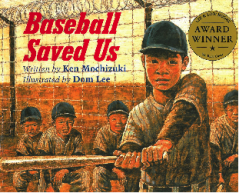
One way to structure close reading questioning is to use the format laid out by the Institute for Learning of the University of Pittsburgh. Under their framework, students read the text selection four times: first, to get the gist; second, to find significant moments or ideas; third, to interpret the ideas in the text; and finally, to analyze the author’s methods (craft). Here’s an example of how to plan out your questions for close reading of just the first 8 pages of Baseball Saved Us:
1st reading (read to get the gist):
- Which characters have we met so far in the story? What do we know about each character so far? Cite evidence from the text to support your answers.
- Where does the story take place? In what country? During what period in history? How do you know? Cite evidence from the text to support your answers.
- How did the characters get to the camp? Why are they there? What is the purpose of the camp? What hardships did the main character’s family face at the camp? How is life at the camp similar to or different from life at home? How does life at the camp affect the people in the story? How do you know? Cite evidence from the text to support your answers.
- Summarize what you have learned about the narrator. How does he see himself? How do others view him? How do you know? Cite evidence from the text to support your answers.
2nd reading (read to find significant moments or ideas):
- What is the most important thing you learned or that happened in this section of the story? Why is it significant? Cite evidence from the text to support your answers.

3rd reading (read to interpret ideas):
- The characters in Baseball Saved Us were Japanese Americans who lived on the West Coast at a time when the United States was fighting a war with Japan. Do you think it was fair for the government to take them from their homes and make them move into an internment camp? Why do you think the government made this decision? Do you agree with the decision? What does it mean to be an American? Do you think the author would agree with you? Do you think the character of Dad would agree with you? Why or why not? Cite evidence from the text to support your answers.
4th reading (read to analyze the author’s methods/craft):
- Based on what you have read so far, how do you think author Ken Mochizuki feels about Japanese internment during World War II? How does he want you to feel about internment camps, specifically about the camp in the story? How do you know? What details does he choose to include in order to influence the reader? Cite evidence from the text to support your answers.
- What is the mood of the story so far? How does illustrator Dom Lee create this mood in his illustrations? Cite evidence from the text to support your answers.
By asking students to ground their responses in the text by citing text-based support for their answers, the following Common Core Standard is addressed:
Reading Literature, Grade 3, Key Ideas and Details, Strand 1: Ask and answer questions to demonstrate understanding of a text, referring explicitly to the text as the basis for the answers.
How does close reading look in your classroom? Any tricks and tips to share?
Further reading:
Filed under:
Curriculum Corner,
Resources Tagged:
Baseball Saved Us,
close reading,
common core standards,
Dom Lee,
Educators,
guided reading,
Ken Mochizuki,
Reading Aloud,
reading comprehension,
slow reading 


By:
Jaclyn DeForge,
on 11/12/2012
Blog:
The Open Book
(
Login to Add to MyJacketFlap)
JacketFlap tags:
literacy,
Language,
Resources,
Educators,
reading comprehension,
close reading,
common core standards,
slow reading,
Curriculum Corner,
guided reading,
close reading in second grade,
Add a tag
 Jaclyn DeForge, our Resident Literacy Expert, began her career teaching first and second grade in the South Bronx, and went on to become a literacy coach and earn her Masters of Science in Teaching. In her column she offers teaching and literacy tips for educators.
Jaclyn DeForge, our Resident Literacy Expert, began her career teaching first and second grade in the South Bronx, and went on to become a literacy coach and earn her Masters of Science in Teaching. In her column she offers teaching and literacy tips for educators.
Before I start discussing close reading in the second grade classroom, I want to take a minute to acknowledge educators and students across the Northeast, who over the past two weeks have dealt with not just superstorm Sandy, but a Nor’easter! Some schools sustained significant flooding and damage, or have classrooms without heat or power. And in some areas, even though the children are back in the classrooms, after a long day teachers and students head home to clean and repair damage sustained to their own homes and communities. And last week, they did that in the wind and snow. If that’s not dedication, I don’t know what is. My thoughts are with everyone who continues to be affected by this awful streak of weather.
Now, back to our regularly scheduled programming. Over the next several weeks, I’ll be modeling how to do a close reading at several different grade levels. Last week, I wrote about close reading in first grade. Next up: Close Reading in Second Grade using the L level text Under the Lemon Moon by Edith Hope Fine and illustrated by Rene King Moreno.
In terms of student questioning, start general and move up Bloom’s Taxonomy by gradually increasing the rigor. For example, say you want to focus your close reading of Under the Lemon Moon on author’s craft, specifically focusing on language and word choice in just the first six pages of the story (2nd grade reading standard for literature, Craft and Structure, strand 4, AND 2nd grade language standards, Vocabulary Acquisition and Use, strands 4-6 from the Common Core Standards). Here are the questions I would ask:
Question 1 (Knowledge): Can you list several examples of onomatopoeia in the story so far? Why do authors use onomatopoeia?
 Question 2 (Comprehension & Analysis): How would you rephrase the meaning of “mi arbolito”? What clues does the author give you as to the meaning of that phrase? What language is that phrase? How do you know? What clues does the author give you? Why do you think the author chose to include Spanish words and phrases in this story?
Question 2 (Comprehension & Analysis): How would you rephrase the meaning of “mi arbolito”? What clues does the author give you as to the meaning of that phrase? What language is that phrase? How do you know? What clues does the author give you? Why do you think the author chose to include Spanish words and phrases in this story?
Question 3 (Comprehension): What details does Edith Hope Fine include on the first page to set the scene for the story? Why does she choose to include these details?
Question 4 (Application): Edith Hope Fine has chosen strong, specific verbs so far. For example, on page 5, she uses the strong, specific verb “crooned” instead of the everyday verb “sang.” What are some other examples of strong, specific verbs that Edith Hope Fine used to describe characters’ actions?
Question 5 (Analysis): In the beginning of the story, instead of telling us Rosalinda scared the Night Man away, Edith Hope Fine described what Rosalinda and Blanca did that caused the Night Man to cry out and run away. Can you identify other parts in the story where the author used that same “show not tell” strategy?
Question 6 (Synthesis): What words or images did the author use to build suspense? What other words or details would you add to the story to further build suspense?
Question 7 (Evaluation): Edith Hope Fine chooses to name the stranger in the garden “Night Man.” Why do you think she made the choice to give him a name? Do you agree with her choice of name? What would you have called the stranger in the garden if you were writing the story?
Additional questions to ask:
- Make a list of words that were unfamiliar to you before you read this story. How did you figure out what these words meant?
- Choose the most important sentence from the story so far. Why did you choose this sentence? Why do you feel it is so important?
- Choose a word that you learned or particularly liked from the beginning of the story. Write the meaning of the word in your own words, then draw a picture that shows what the word means.
- Choose a word that best represents the story so far. Is there a time in your life when this word applied to or was important to you? Is there a time when this word was important in another text you read?
- List some descriptive words Edith Hope Fine uses to set the scene or to show characters thoughts, actions and feelings.
- What techniques did the author use to hook you into the story? To make the story suspenseful? To make the writing lively?
- So far, what word best describes Rosalinda? Cite evidence from the text to support your answer.
- What words or phrases from the story helped you visualize the story?
What are your favorite questions to ask when doing a close reading focused on author’s craft, language and word choice?
Further reading:
What does close reading look like in First Grade?
What does close reading look like in Kindergarten?
What is close reading?
Filed under:
Curriculum Corner,
Resources Tagged:
close reading,
close reading in second grade,
common core standards,
Educators,
guided reading,
Language,
literacy,
reading comprehension,
slow reading 


By:
Jaclyn DeForge,
on 10/15/2012
Blog:
The Open Book
(
Login to Add to MyJacketFlap)
JacketFlap tags:
Resources,
Reading Aloud,
kindergarten,
reading comprehension,
close reading,
common core standards,
slow reading,
bloom's taxonomy,
Curriculum Corner,
guided reading,
rigor,
reading,
literacy,
Add a tag
Jaclyn DeForge, our Resident Literacy Expert, began her career teaching first and second grade in the South Bronx, and went on to become a literacy coach and earn her Masters of Science in Teaching. In her column she offers teaching and literacy tips for educators.
Over the next several weeks, I’ll be modeling how to do a close reading at several different grade levels. First up: Close Reading in Kindergarten using the D level text Bedtime Fun by Barbara J. Newkirk and illustrated by Laura Freeman.
In terms of student questioning, start general and move up Bloom’s Taxonomy by gradually increasing the rigor. For example, say you want to focus your close reading of Bedtime Fun on character development. Here are the questions I would ask:
Question 1 (Knowledge): Who is the main character in the story? Who is the story mostly about? Who are the other characters in the story? How do you know?
 Question 2 (Comprehension): What was the big thing that the entire story was about? How do you know?
Question 2 (Comprehension): What was the big thing that the entire story was about? How do you know?
Question 3 (Comprehension): Can you explain what is happening on page 3? On page 4? On page 6? How does the little boy change over the course of the story? What clues does the illustrator give us that show that the little boy is changing? How do you know?
Question 4 (Application): What would have happened if the little boy had tried to lay down and go to sleep after page 4? What makes you think that?
Question 5 (Analysis): Why do you think the little boy chose to play with his bear, jump on his bed, stand on his head, etc? What makes you think that? Make a connection to your own life or to another book you’ve read to support your answer.
Question 6 (Analysis): How would you describe the little boy? What is he like? How does he behave? How do you know?

Question 7 (Synthesis): Can you think of another thing the little boy could have done so he could stay up later?
Question 8 (Evaluation): What did you think of the little boy? Did you agree with the choices he made? Think about the author. Did you like the choices she made for the main character? Did you like the way the author ended the story? Why or why not?
Additional questions to ask:
- How does the main character remind you of yourself or of a character in another book you’ve read?
- Why do you think the author included Mama and Papa in the story?
- How do you think the little boy probably behaves when it’s time to get up and get ready for school? What makes you think that?
- What is important to the little boy? How do you know?
- What did the author do to make the little boy realistic?
Even an 8 page book can serve as the foundation for some rigorous student discussions when read closely!
What are your favorite questions to ask when doing a close reading focused on character development?
Filed under:
Curriculum Corner,
Resources Tagged:
bloom's taxonomy,
close reading,
common core standards,
guided reading,
kindergarten,
literacy,
reading,
Reading Aloud,
reading comprehension,
rigor,
slow reading 


By:
Jaclyn DeForge,
on 10/9/2012
Blog:
The Open Book
(
Login to Add to MyJacketFlap)
JacketFlap tags:
reading comprehension,
close reading,
common core standards,
slow reading,
Curriculum Corner,
guided reading,
literacy,
Resources,
Read Aloud,
Add a tag
 Jaclyn DeForge, our Resident Literacy Expert, began her career teaching first and second grade in the South Bronx, and went on to become a literacy coach and earn her Masters of Science in Teaching. In her column she offers teaching and literacy tips for educators.
Jaclyn DeForge, our Resident Literacy Expert, began her career teaching first and second grade in the South Bronx, and went on to become a literacy coach and earn her Masters of Science in Teaching. In her column she offers teaching and literacy tips for educators.
One of the most critical elements of the new Common Core Standards is the emphasis placed on close reading. In the anchor standards for reading for grades K-12, the first item under the heading Key Ideas and Details states that students should be able to:
“Read closely to determine what the text says explicitly and to make logical inferences from it; cite specific textual evidence when writing or speaking to support conclusions drawn from the text.” (pages 10, 35, 60)
In the past, some curricula spent a huge amount of time on the accuracy and speed at which a student was able to read, and stopped there. This emphasis on fluency isn’t necessarily a bad thing, as long as the teacher recognizes that just because students sound fluent, it doesn’t automatically mean they’ve fully understood what they’ve read. Making meaning from text is a process and should be explicitly taught during every Read Aloud and Guided Reading.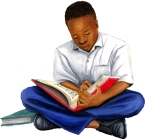
The Common Core’s mention of close reading shifts the collective focus back to meaning. It asks teachers to spend time with rigorous, complex texts, reading and rereading a text, moving from the big ideas to paragraphs to sentences to individual word choice, focusing on meaning and craft in a thorough way. Time is still spent on retelling the story and basic comprehension questions, but the bulk of the discussions focus on meatier topics such as word choice, author’s purpose, character development, mood, etc. In my opinion, those lessons are incredibly interesting to plan and a lot of fun to teach because the student discussions that result (after sustained practice at this slow, deliberate reading) are really insightful!
But what does close reading look like in practice? Over the next few weeks, I’m going to walk you through how to do a close reading using several of our titles. Hopefully this modeling will demystify the process and help you as you plan more Read Alouds centered on close reading!
Filed under:
Curriculum Corner,
Resources Tagged:
close reading,
common core standards,
guided reading,
literacy,
Read Aloud,
reading comprehension,
slow reading 

 I highly recommend all educators and parents read a bookseller’s perspective on leveling systems, Lexile in this case, which we re-posted on our blog last week. There are great firsthand examples of parents and booksellers striving in earnest to help children improve in reading.
I highly recommend all educators and parents read a bookseller’s perspective on leveling systems, Lexile in this case, which we re-posted on our blog last week. There are great firsthand examples of parents and booksellers striving in earnest to help children improve in reading. Below are strategies for strengthening the communication lines, sharing resources and context, and building a community invested in each child’s education. In doing so, we show our students, children, and customers that they have a whole team cheering for them and invested in their growth, joy, and success.
Below are strategies for strengthening the communication lines, sharing resources and context, and building a community invested in each child’s education. In doing so, we show our students, children, and customers that they have a whole team cheering for them and invested in their growth, joy, and success. Jill Eisenberg, our Resident Literacy Specialist, began her career teaching English as a Foreign Language to second through sixth graders in Yilan, Taiwan as a Fulbright Fellow. She went on to become a literacy teacher for third grade in San Jose, CA as a Teach for America corps member. She is certified in Project Glad instruction to promote English language acquisition and academic achievement. In her column she offers teaching and literacy tips for educators.
Jill Eisenberg, our Resident Literacy Specialist, began her career teaching English as a Foreign Language to second through sixth graders in Yilan, Taiwan as a Fulbright Fellow. She went on to become a literacy teacher for third grade in San Jose, CA as a Teach for America corps member. She is certified in Project Glad instruction to promote English language acquisition and academic achievement. In her column she offers teaching and literacy tips for educators. 



 As we cluster in workshops, around webinars, and near the water cooler, we are already thinking about and preparing what skills and knowledge we want to teach. Yet, to truly have a successful year, let’s ponder an additional question: who do we want to teach?
As we cluster in workshops, around webinars, and near the water cooler, we are already thinking about and preparing what skills and knowledge we want to teach. Yet, to truly have a successful year, let’s ponder an additional question: who do we want to teach? Have protagonists that both exemplify and struggle with at least one of the classroom’s core values. Don’t just present stories with perfect, role model-worthy characters! Students should see multiple examples of people and situations of the core value in action to learn that one’s character is made, not born. Finding books where characters (protagonists and antagonists) lie, cheat, lose their cool, or are hurtful to other characters can be just as powerful as exemplary characters, if not more so. Students can discuss what they can learn from both examples and non-examples, share advice for different scenarios, and reflect on similar experiences in their lives where they struggled to make the right decision.
Have protagonists that both exemplify and struggle with at least one of the classroom’s core values. Don’t just present stories with perfect, role model-worthy characters! Students should see multiple examples of people and situations of the core value in action to learn that one’s character is made, not born. Finding books where characters (protagonists and antagonists) lie, cheat, lose their cool, or are hurtful to other characters can be just as powerful as exemplary characters, if not more so. Students can discuss what they can learn from both examples and non-examples, share advice for different scenarios, and reflect on similar experiences in their lives where they struggled to make the right decision.

 As media coverage has intensified around the events of children crossing the U.S. border, many educators and families are wondering, “What should we tell our students?” For some children, this may be the first time they are learning of these countries. But for many others, these events may involve their own heritage or depict their families’ experiences. Using books to talk about the recent events can be an opportunity to learn about a new region and help children see the cultures and people beyond these events.
As media coverage has intensified around the events of children crossing the U.S. border, many educators and families are wondering, “What should we tell our students?” For some children, this may be the first time they are learning of these countries. But for many others, these events may involve their own heritage or depict their families’ experiences. Using books to talk about the recent events can be an opportunity to learn about a new region and help children see the cultures and people beyond these events.
 2.
2. 
 4.
4.  5.
5. 






































 This week, another look at the Common Core State Standards (CCSS).
This week, another look at the Common Core State Standards (CCSS).  Jaclyn DeForge, our Resident Literacy Expert, began her career teaching first and second grade in the South Bronx, and went on to become a literacy coach and earn her Masters of Science in Teaching. In her column she offers teaching and literacy tips for educators.
Jaclyn DeForge, our Resident Literacy Expert, began her career teaching first and second grade in the South Bronx, and went on to become a literacy coach and earn her Masters of Science in Teaching. In her column she offers teaching and literacy tips for educators.










Let’s Hear It For Almigal…Almigal doesn’t let her hearing loss define her and reminds kids that we are all special in different ways. Palm Beach County Schools (FL) has recognized Almigal as a book that addresses their core values.